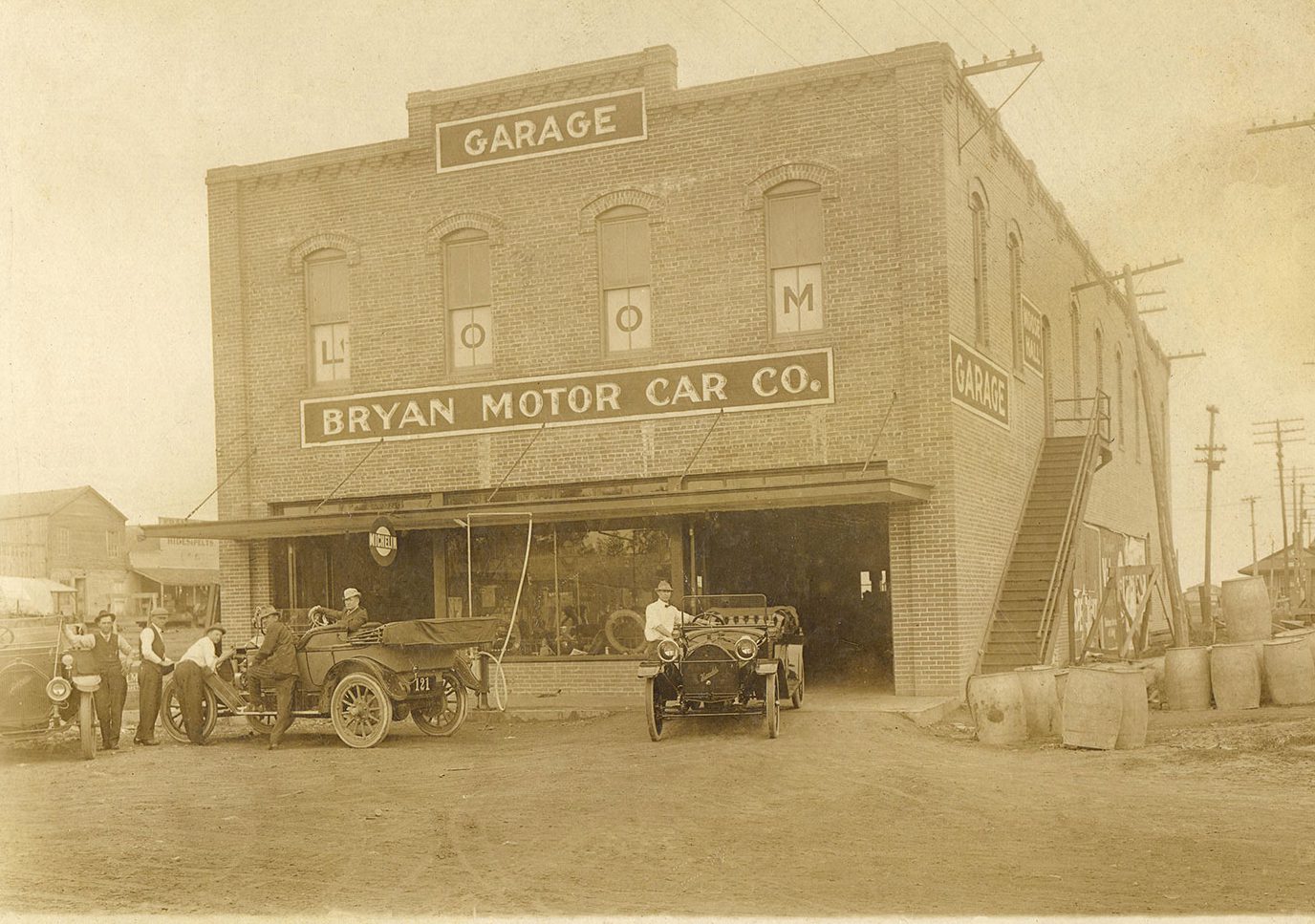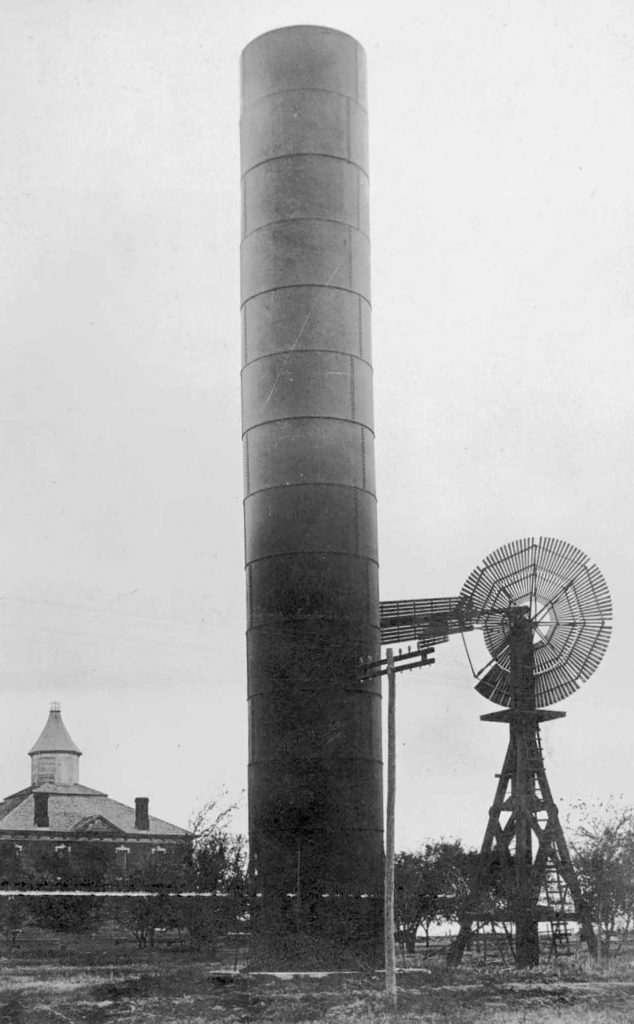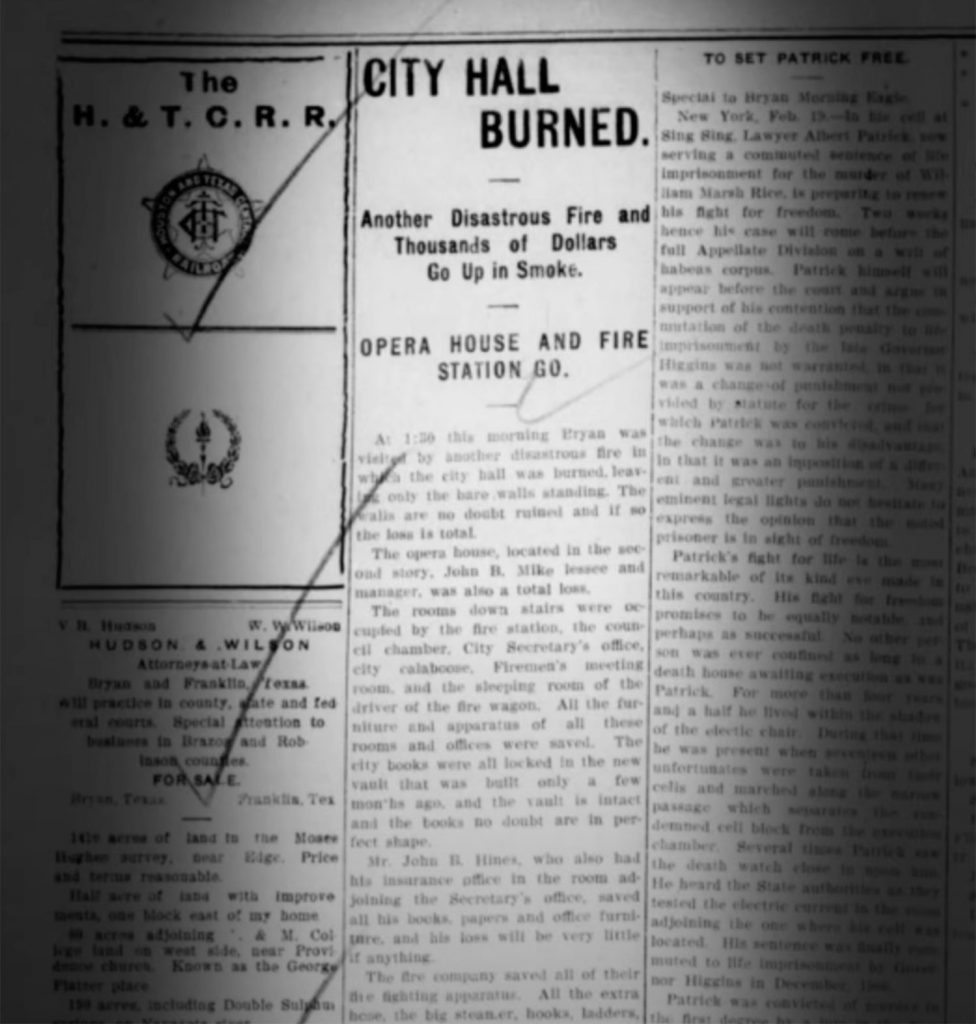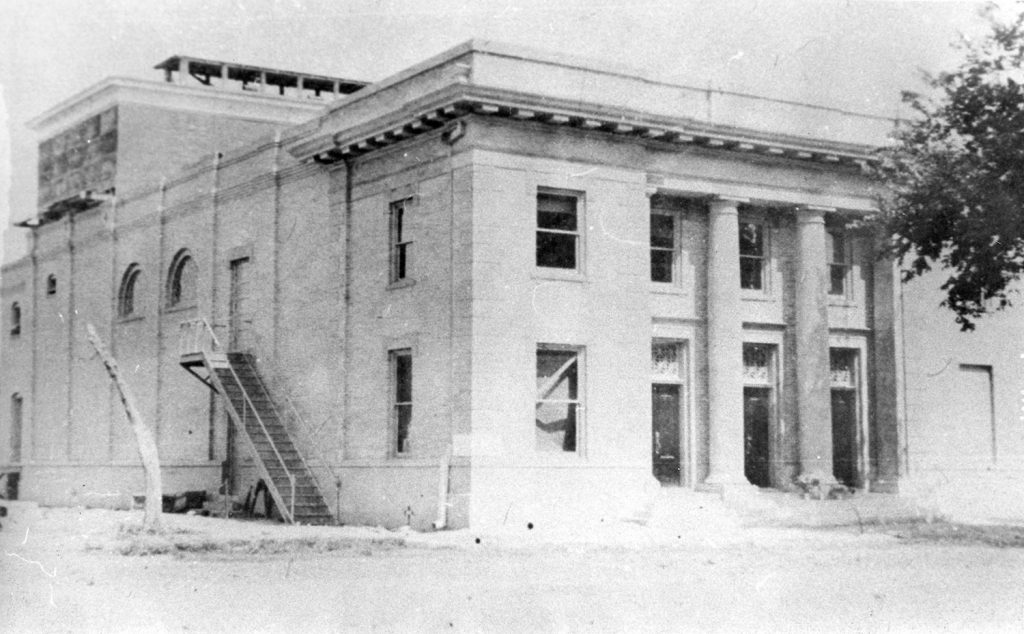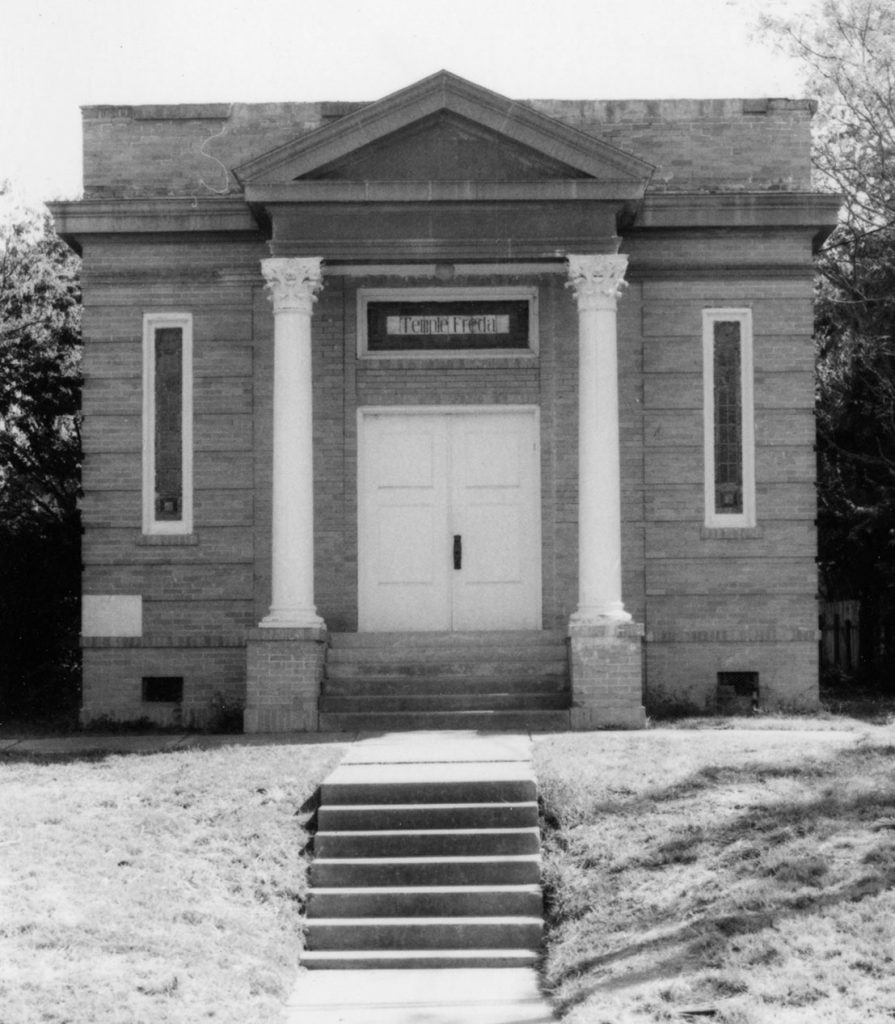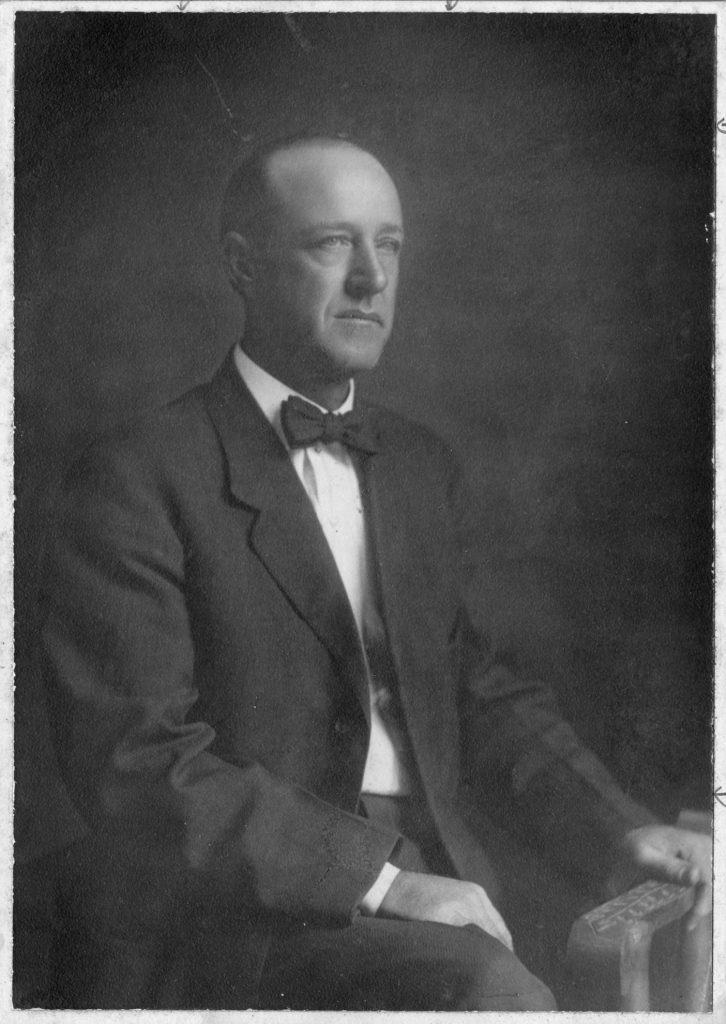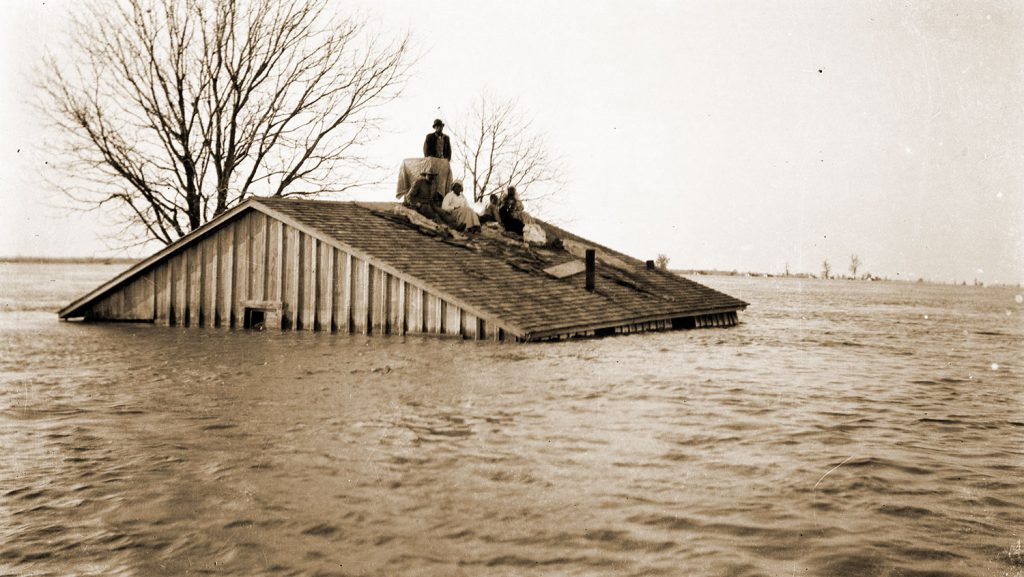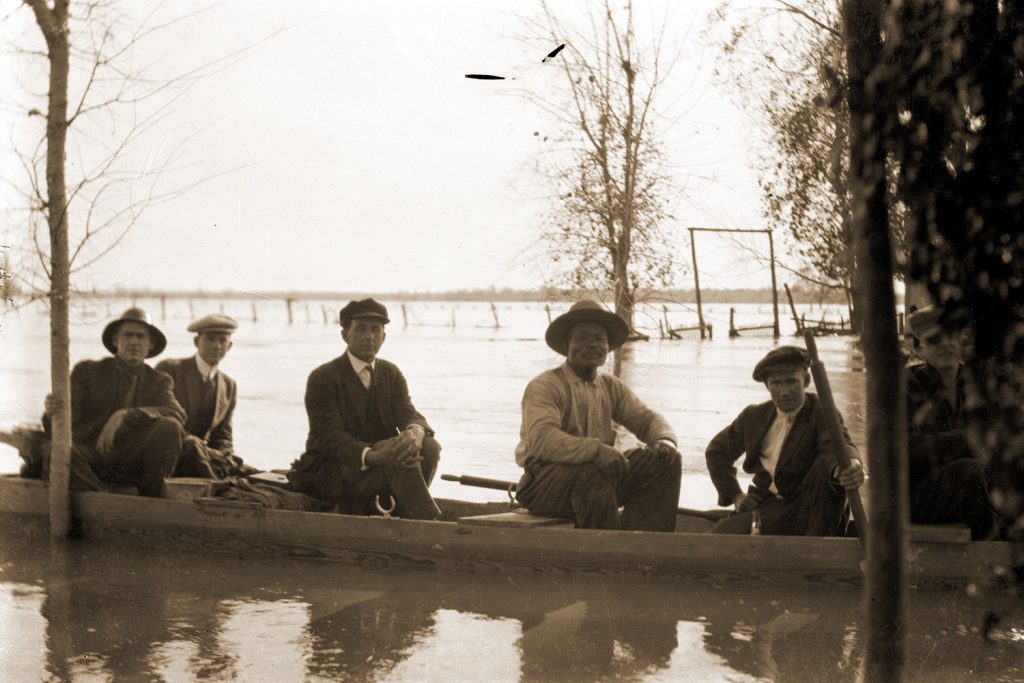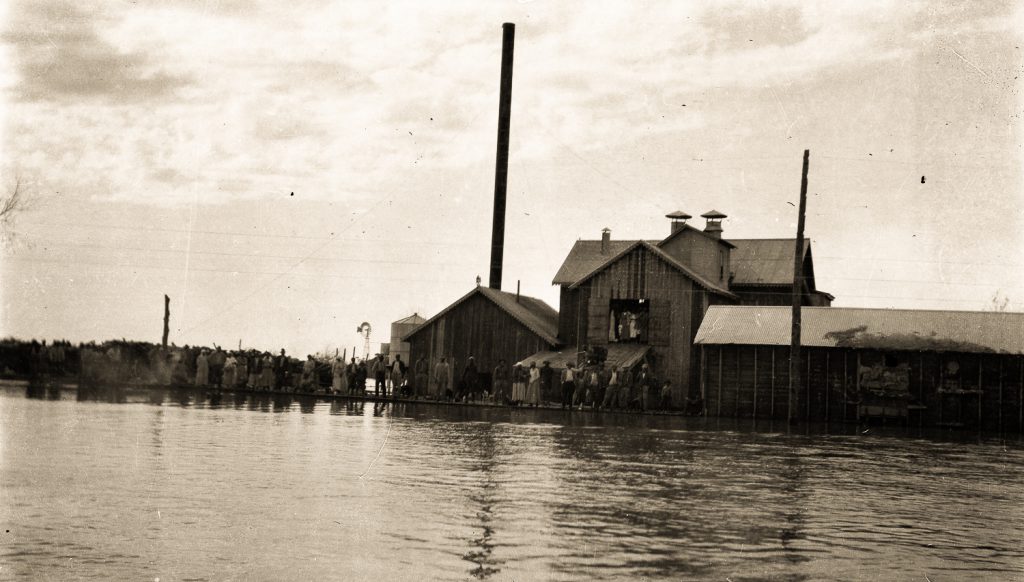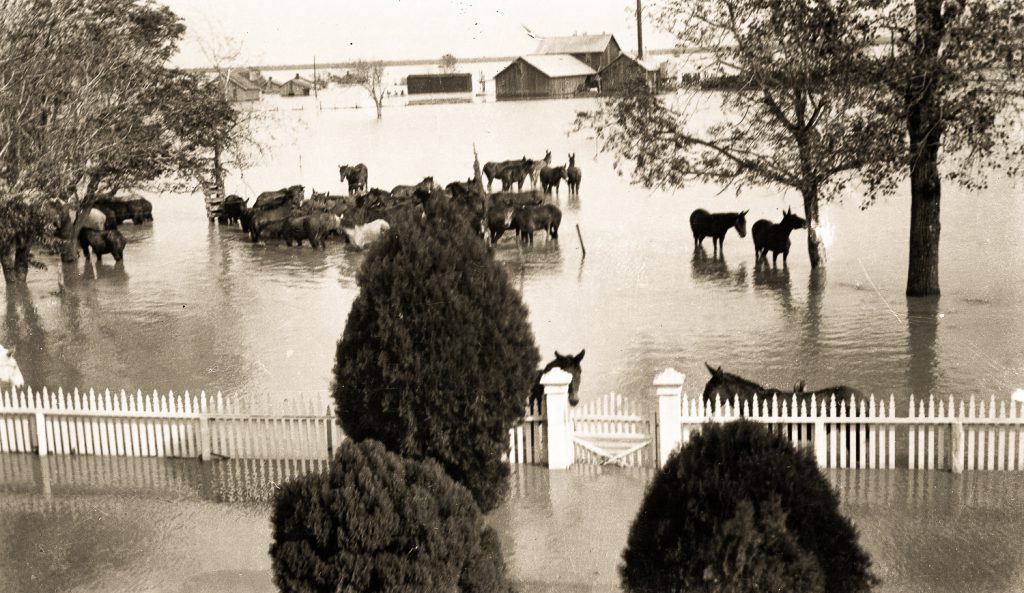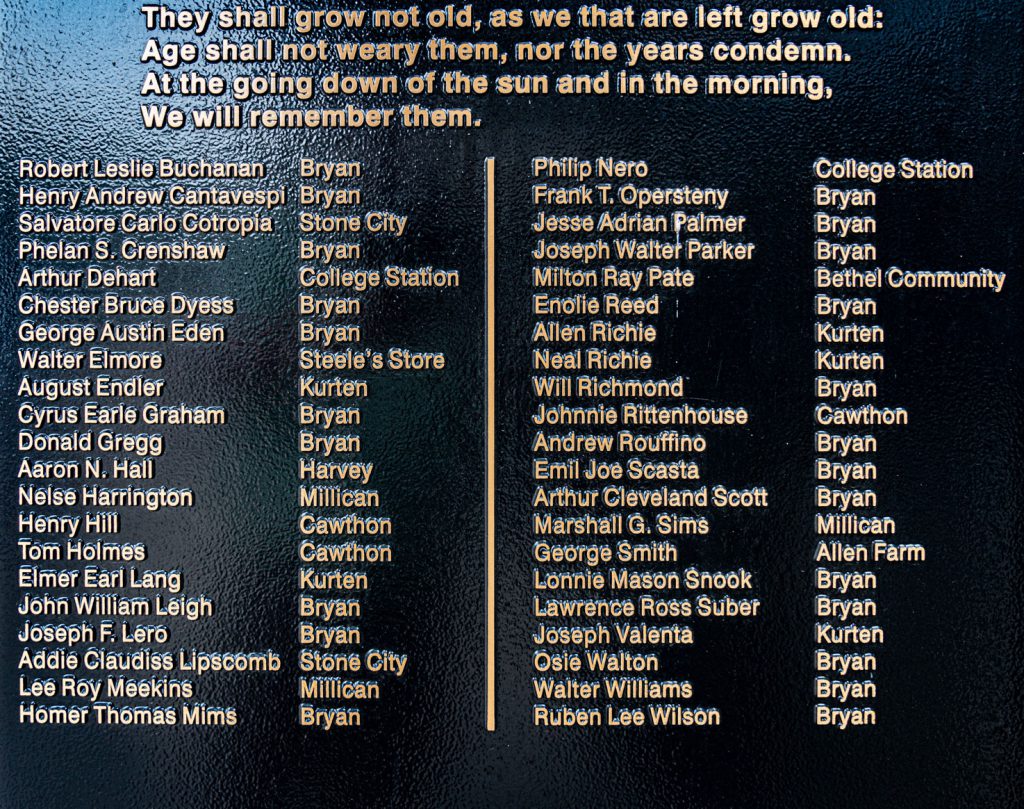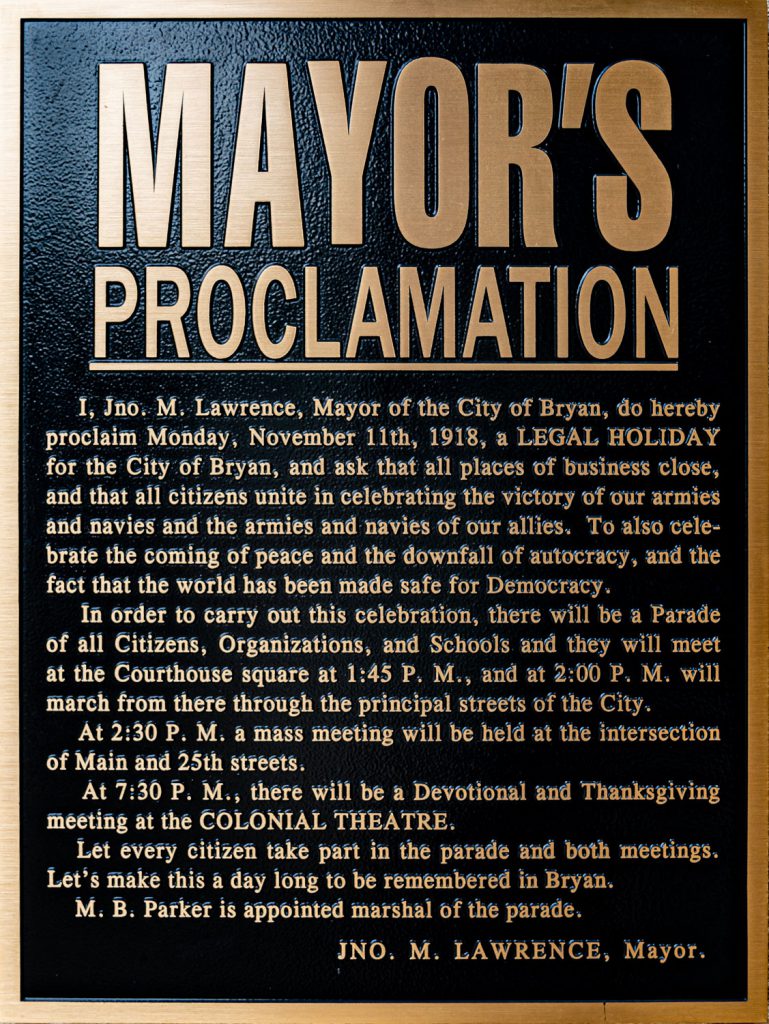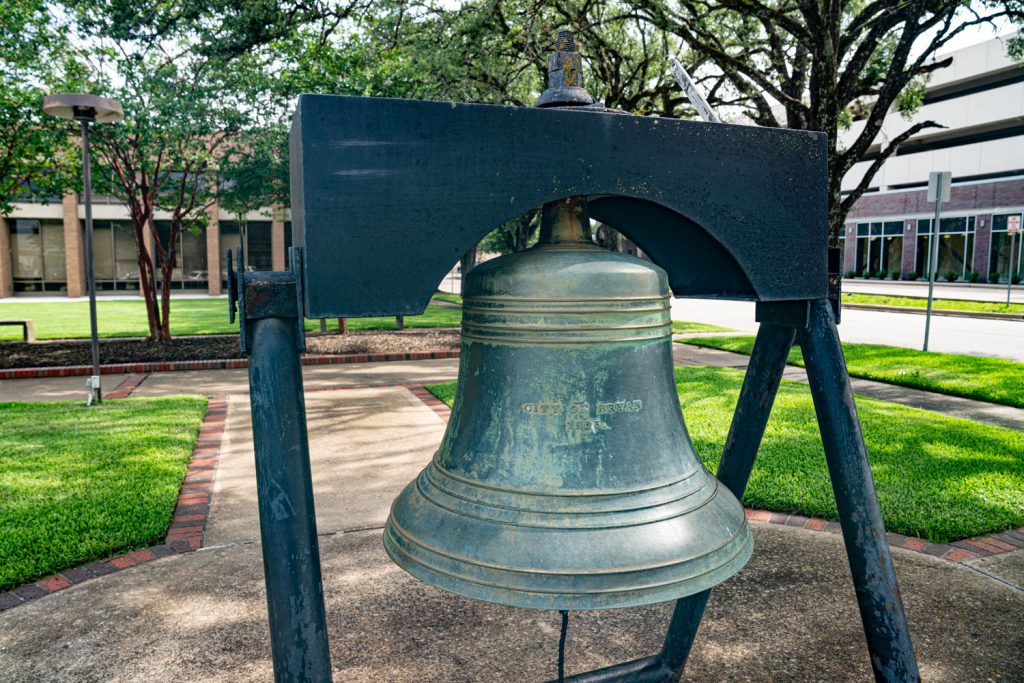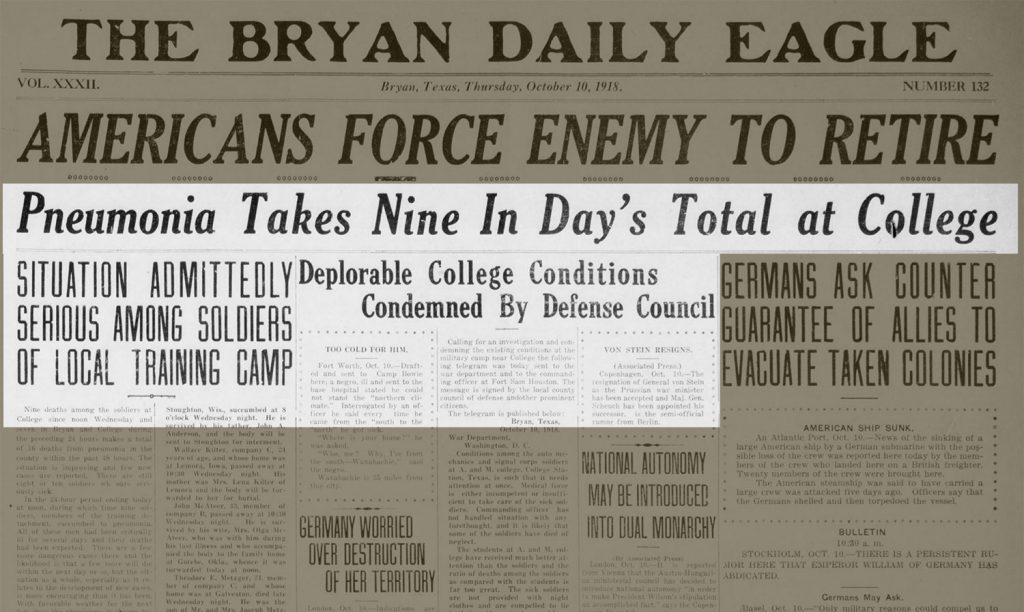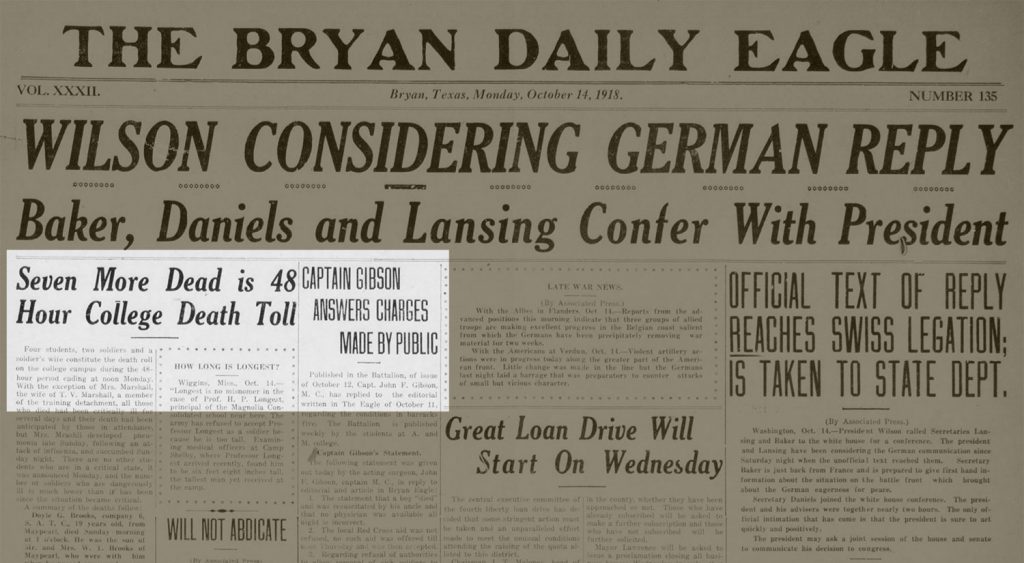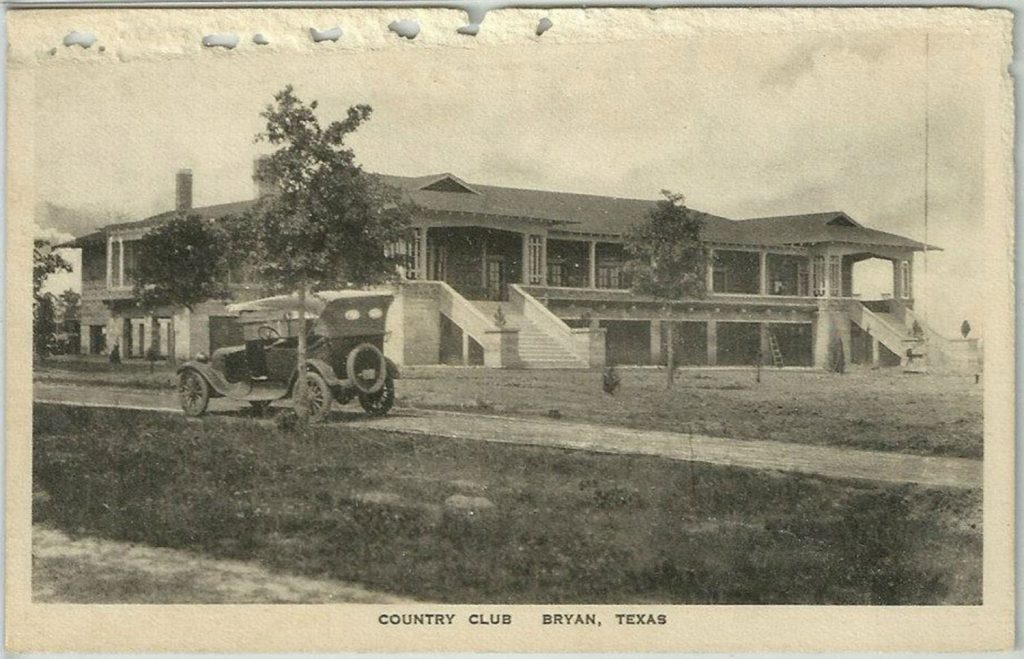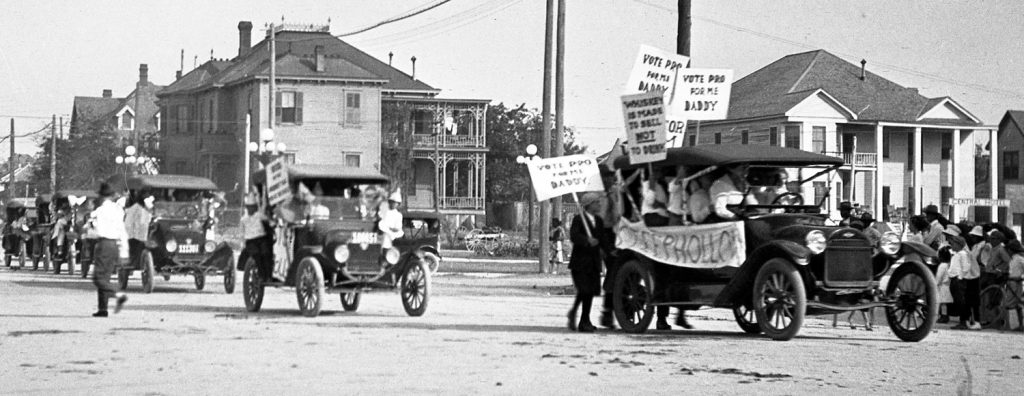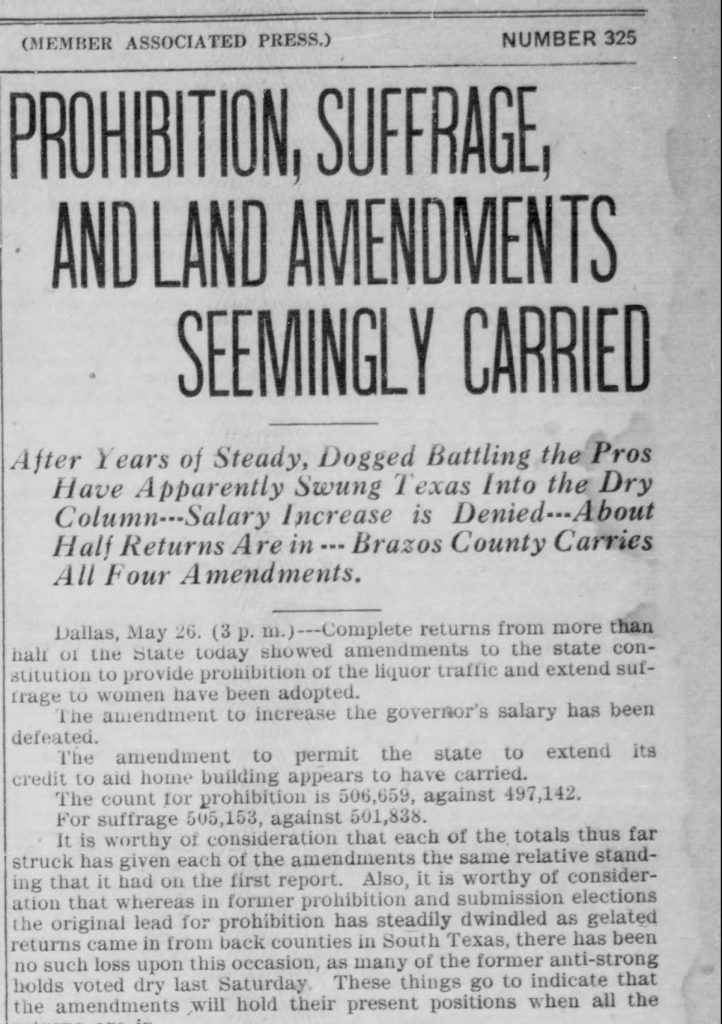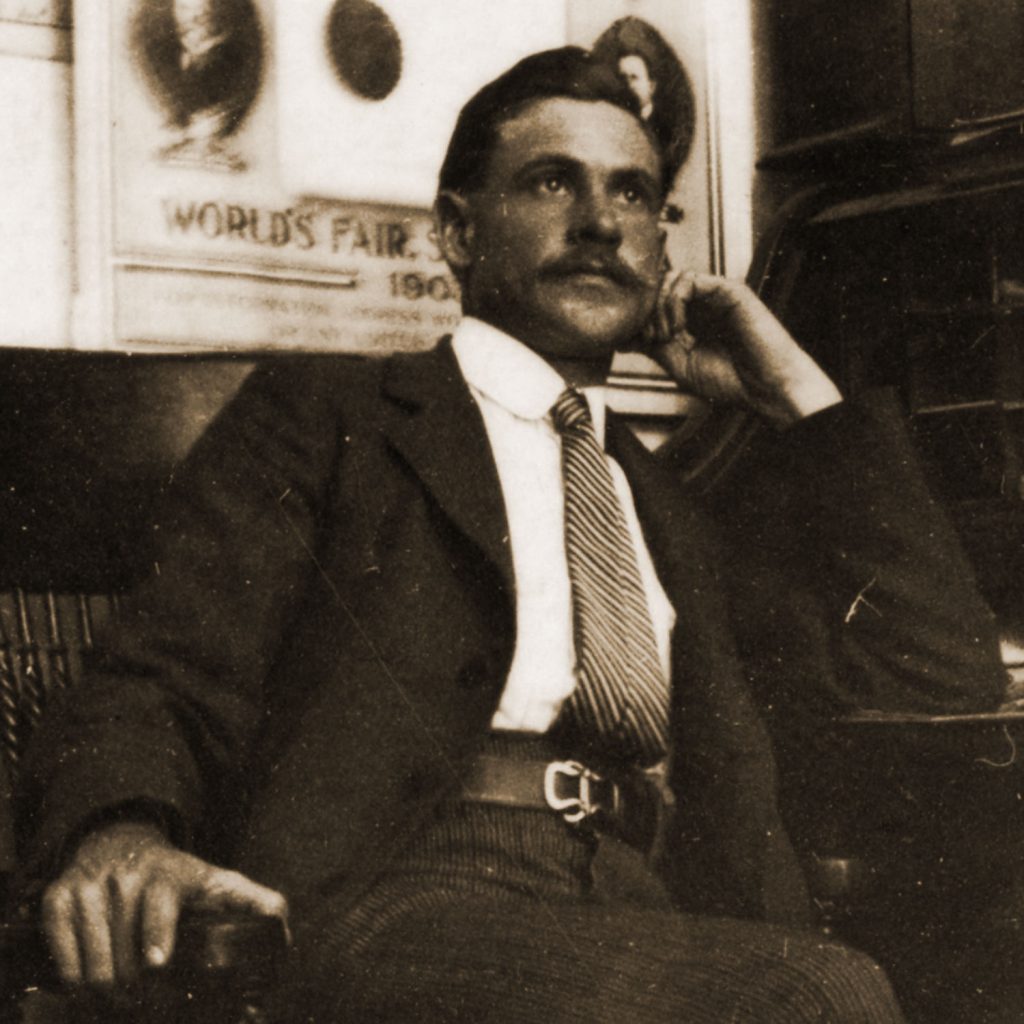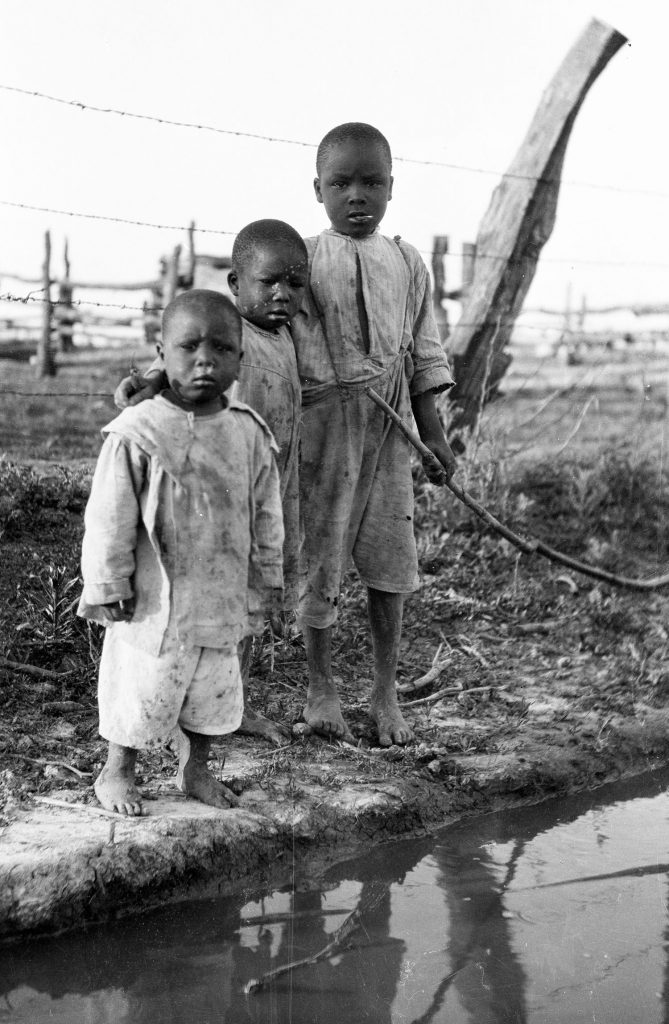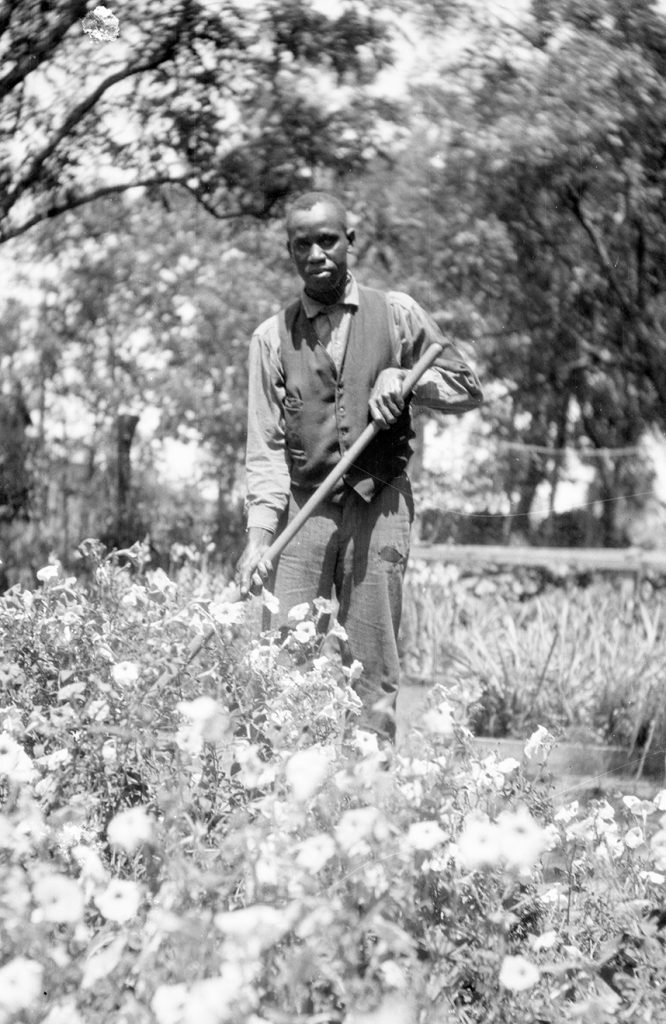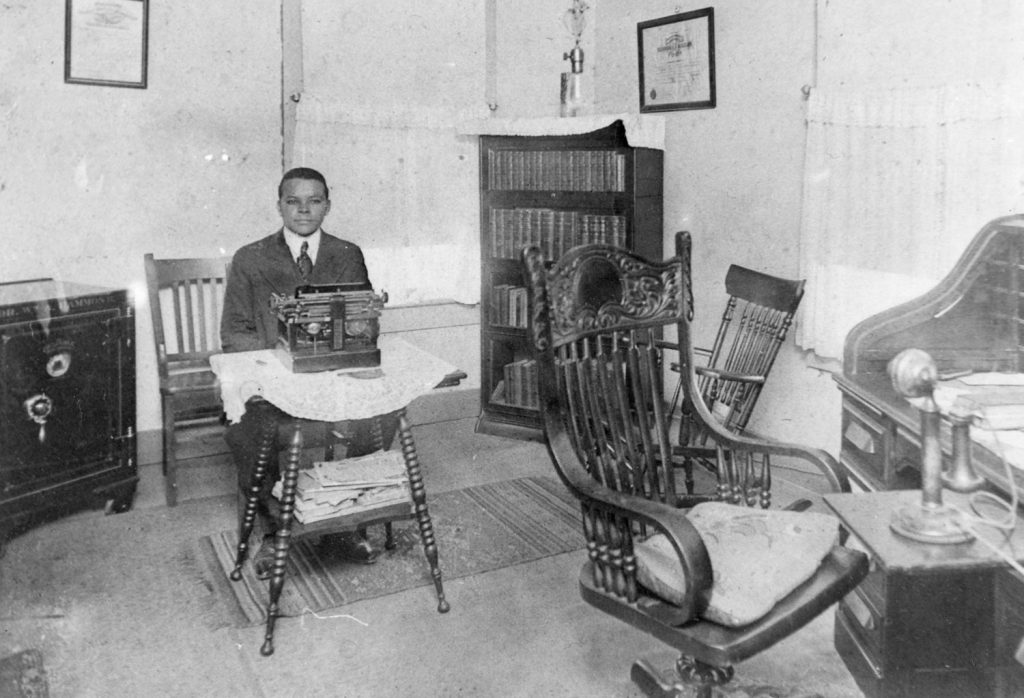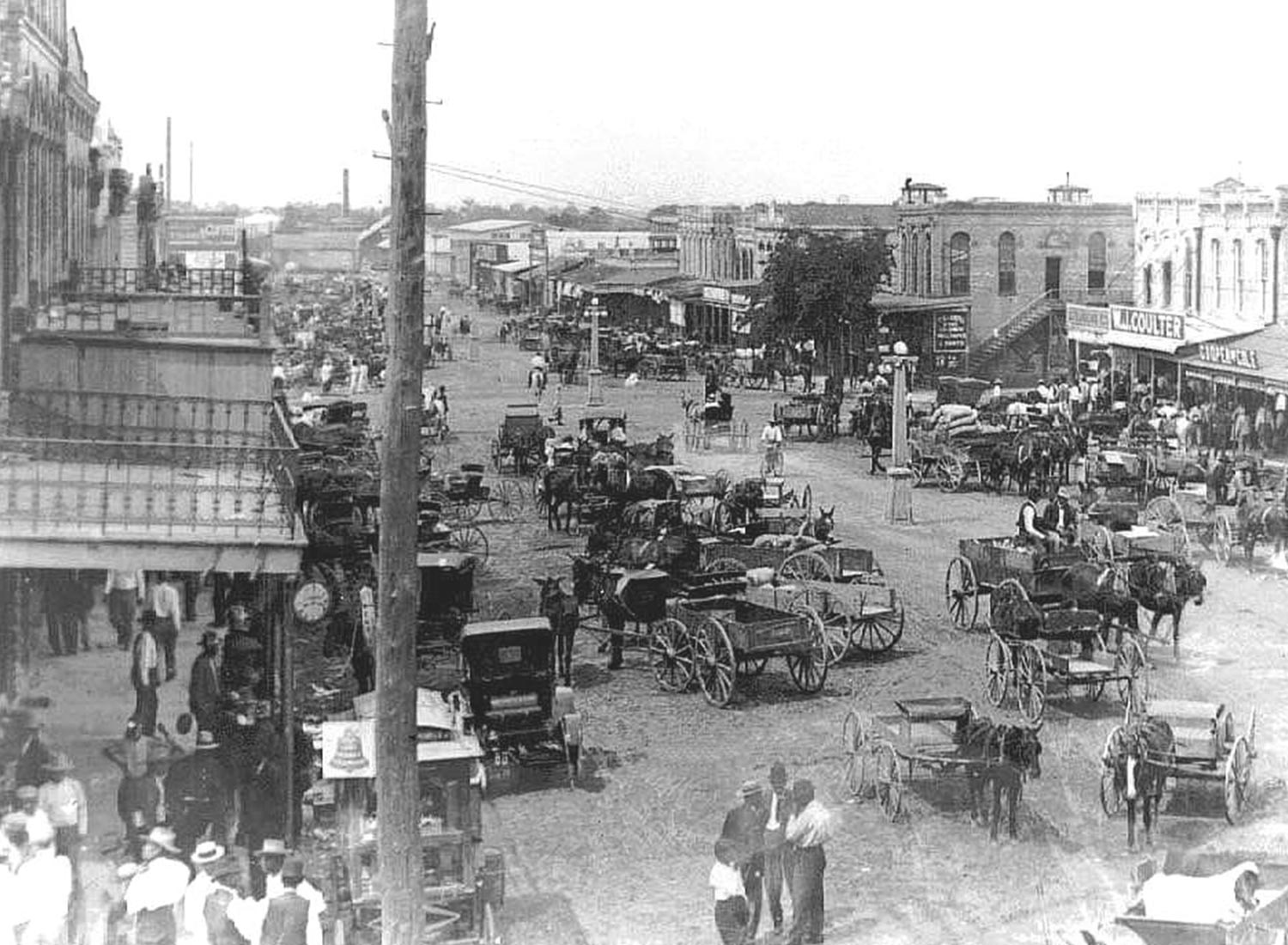
20th Century to the Roaring 20s
1901-1930
It’s the dawn of a new century in Bryan. Now, that sounds poetic and grandiose, but to say that the year 1901 would have been much different than the year 1899 in the City of Bryan wouldn’t really be accurate for most people. However, changes were coming: Changes that would affect daily life in Bryan more dramatically than anything else in the city’s history. And amid these changes, the foundations of the Bryan we know today were formed.
1901: Villa Maria Ursuline Academy for girls moves to Bryan

After the storm: Villa Maria Ursuline Academy and Convent moved to Bryan after its Galveston facility was destroyed during the hurricane of 1900. In spite of a beautiful 50-acre campus that was connected to Main Street via the interurban trolley in 1913, the academy was never able to enroll enough students to sustain itself. In the summer of 1929, the Sisters moved back to Galveston, where their convent had been restored.
A car, the Carnegie and a whole lot of cotton
Bryan welcomed the car era in 1901, when the first automobile arrived. But it wasn’t called an automobile. It was a Locomobile owned by M. Bonneville, and it was powered by steam!
The Locomobile brand would later become known as the “Best Built Car in America,” as well as one of the most expensive and elegant automobiles manufactured in the United States. But to say that this first steam-powered car in Bryan was a nuisance probably wouldn’t be far off the mark. It was noisy, it was dirty, and it was just a bit dangerous. But it did signal the beginning of a new era for the city.
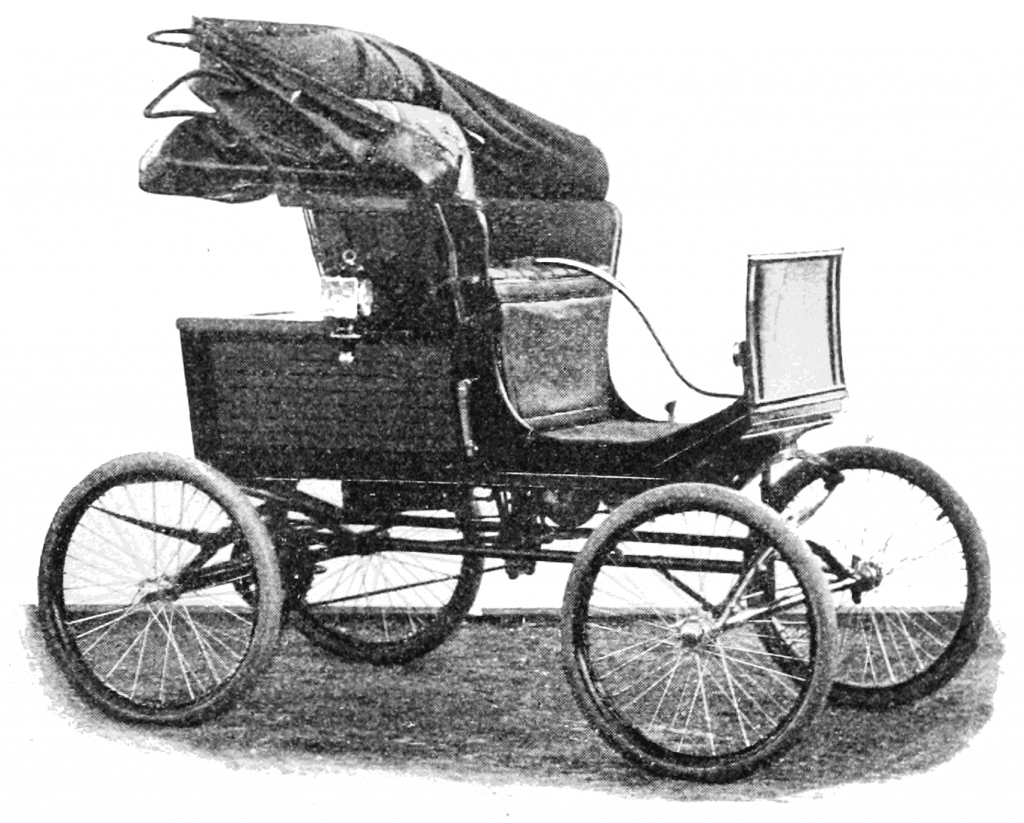
Bryan enters the auto era: Above is an example of a Locomobile from 1900 that would have been similar to Mr. Bonneville’s steam-powered vehicle that arrived in Bryan in 1901. Members of the Cavitt family owned and operated the Bryan Motor Car Company for many years. By 1906 Bryan residents had purchased enough automobiles, as you can see from this picture of cars parked along the railroad tracks in Downtown Bryan, that the city instituted a speed limit of 8 mph.
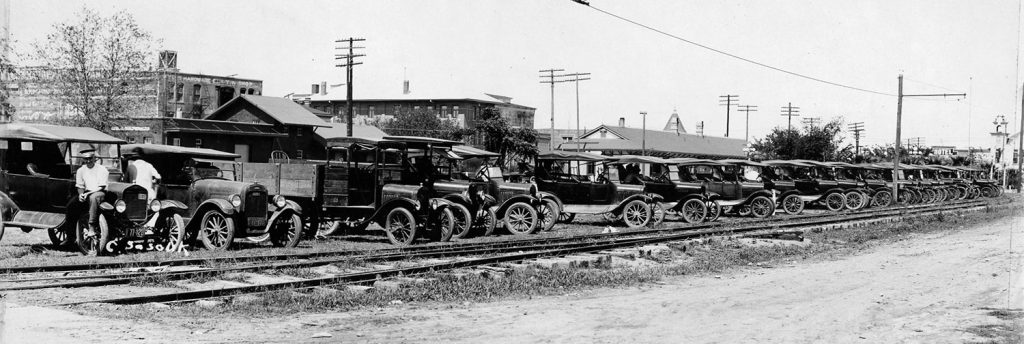
With the development of gasoline-powered autos, the car industry really took off. By 1906 enough automobiles had been purchased by residents of Bryan that city leaders were prompted to set a speed limit of 8 miles per hour. It was probably a pretty bumpy ride anyway if you were going faster than that, since no Bryan roads would be paved until 1915.
Main Street may have been unpaved, but that didn’t reflect the level of sophistication and refinement shown by many of Bryan’s residents in the early 1900s. One prime example of this was the desire to found a public library.
In 1902, the Mutual Improvement Society, later known as the Woman’s Club, was instrumental in securing a grant of $10,000 from the Andrew Carnegie Foundation for the construction of the city’s first public library. The city donated the property at 111 S. Main St., and construction commenced.
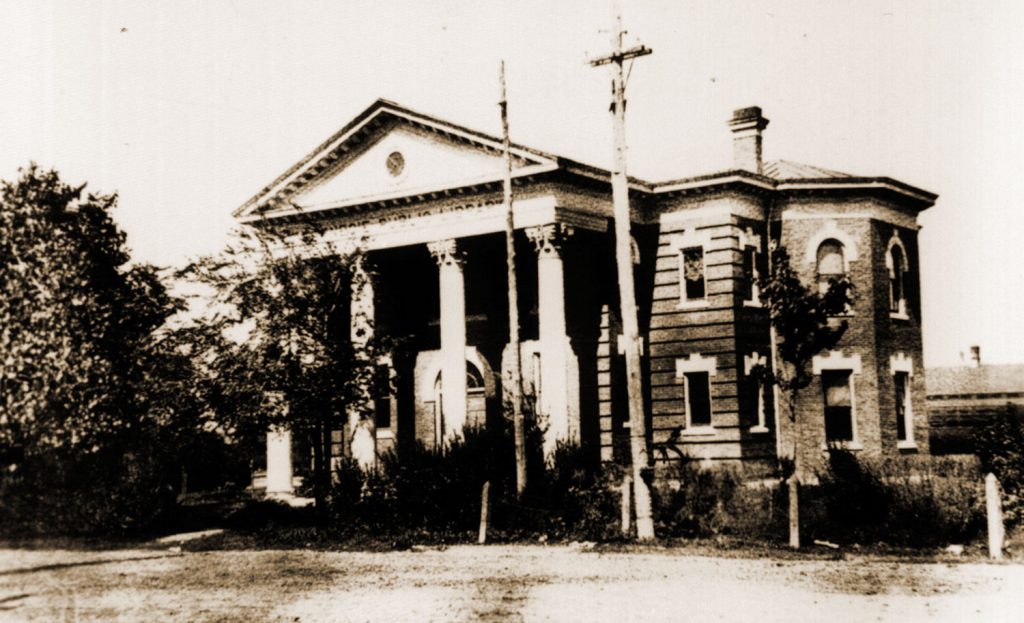
The keeper of history: The Carnegie Library in Downtown Bryan, seen here in the early 1900s, is the oldest Carnegie Library in Texas that is still used for its original intended purpose – as a library.
Designed in Classic Revival style by F. E. Giesecke, a professor of architecture and college architect at Texas A&M, the Carnegie Public Library building opened in 1903. For decades the Carnegie served as Bryan’s public library and was a civic and cultural center for the community.
1905: Bryan Baptists found the Texas Women’s College. Dr. George B. Butler, pastor of First Baptist Church, serves as its first president.
1905: West Side School opens on 26th Street to relieve overcrowding and keep younger children from having to cross the railroad tracks to get to school. The Bowie School building occupies this site today.
1906: James Drugstore at 200 W. 26th St. is founded. A classically detailed commercial structure, the building was in use as a drugstore into the 2000s. It is currently the site of RX Pizza.
1906: The Howell Building at 200 S. Main St. is constructed and built of solid brick walls. The interior cast-iron columns support the two upper stories. The two-part, vertical block structure housed J. W. Howell’s wholesale grocery business.
Andrew Carnegie, the steel magnate and philanthropist, was the largest individual investor in public libraries in American history. His funds helped establish 2,800 libraries around the world. Ours is the oldest operating Carnegie Library in Texas.
While new ideas, industries and technology were arriving in Bryan, advancements weren’t just being made in an urban setting. In the first decade of the 20th century, the roots of our greater community were still squarely based in agriculture, and you could begin to see the benefits of having an agricultural research college just outside of Bryan.
In 1906, more wagon cotton was brought to market in Bryan than any other town or city in the world. That’s a lot of cotton. A unique and symbiotic relationship was growing between A&M, the agricultural community and Bryan itself.
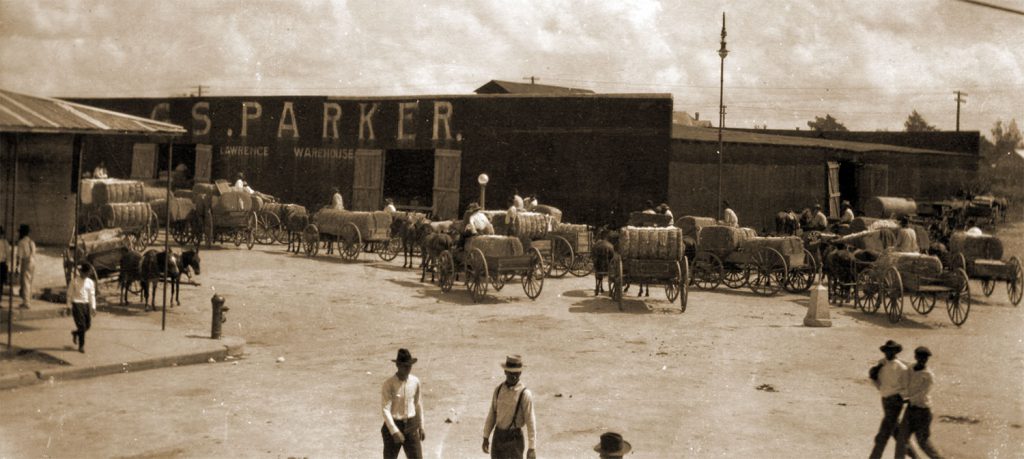
High cotton: In 1906, Bryan boasted more wagon cotton brought to market than any other city in the world. Much of it would have come to G.S. Parker’s cotton gin in north Downtown Bryan.
The two fires that changed everything
History contains certain moments that become turning points – events of such magnitude that the course of history is forever changed by them. American and Texas history is full of these legendary stories, and in early 1909 a series of events occurred that would forever change the City of Bryan’s role in the daily lives of residents.
It began on Jan. 15, 1909, at about 6:30 a.m., when the Perkins Building at the northwest corner of what today are Main Street and William J. Bryan Parkway caught fire. This building, also known as the Astin Building, was the home of First National Bank, a grocer, a saloon and several other offices on the second floor, including the offices and printing press of the Brazos (Bryan Evening) Pilot newspaper.
A turning point in Bryan’s history: Listen to City of Bryan historian Randy Haynes as he recounts the events and outcomes of the two major 1909 Downtown Bryan fires.
According to the account of the fire and its aftermath, as reported in the Bryan Morning Eagle on Jan. 16, 1909, the blaze started in the business office of the Pilot and spread through the composing room of the newspaper. Once the second-floor supports had burned through, the paper’s printing presses and machinery fell through the floor into the saloon below.
The real issue, however, was the lack of water pressure to allow the fire department to fight the fire. From the Eagle article:
The fire was fought with buckets on account of the weak water pressure from the fire hydrants. Chief Hamilton stated to the Eagle man that, had there been the usual pressure, he could have confined the blaze to the second floor of the building, and believes that he could have prevented it burning into the press room of the Pilot office. Mr. Daly and others who fought the fire with the chief and members of the department are of the same opinion.”
– Bryan Morning Eagle, Jan. 16, 1909, Page 4.
Members of the Bryan City Council called a special session for 11:30 a.m. and invited Mr. Preston, the superintendent of the waterworks of the Bryan Water, Ice, and Electric Light Company, to come before the council and explain the failure. Again, the report from the Eagle:
When Mr. Preston arrived he was questioned particularly by the mayor and interrogated incidentally by members of the council in regard to the insufficiency of the supply of water.”
– Bryan Morning Eagle, Jan. 16, 1909, Page 4.
The questioning was extensive, and the Eagle ran a detailed transcript of the exchange. Basically, both of the water pumps broke at the same time, and there was not much water in the standpipe (a version of water tower) to provide sufficient water pressure.
The city council ordered more investigation of the failure, and then went a big step further, also ordering that a bond election be held to issue $75,000 in bonds for establishing a city-owned water, light and sewerage plant. The bond election was scheduled for March 2, 1909.
But before the bond election could even take place, a fire disaster struck yet again. And this time, it struck the city government directly.
In the very early morning of Feb. 20, 1909, fire engulfed the Opera House building, which also housed the Bryan City Hall and Fire Station. The fire apparently started in the backstage area of the Opera House, which encompassed the second floor of the building, and it was difficult for firefighters to get close enough to fight the blaze effectively. Then the roof of the building went up in flames.
According to the Eagle’s reports of this fire, the building was lost, but most of the contents of the first floor were able to be saved.
Jan. 24, 1909: Brazos Pilot and Bryan Morning Eagle merge after Pilot offices and presses burn in Perkins Building fire nine days earlier.
The rooms down stairs were occupied by the fire station, the council chamber, City Secretary’s office, city calaboose, Firemen’s meeting room, and the sleeping room of the driver of the fire wagon. All the furniture and apparatus of all these rooms and offices were saved. The city books were all locked in the new vault that was built only a few months ago, and the vault is intact and the books no doubt are in perfect shape.”
– Bryan Morning Eagle and Pilot, Feb. 20, 1909, Page 4.
While it does not appear that a lack of water pressure was necessarily an issue in this specific fire, Bryan’s citizens had seen enough. Two total-loss fires at two major downtown buildings within a few weeks of each other was not acceptable for a city of Bryan’s stature. Bryan needed its own municipally run utility to guarantee the safety and security of its residents and property.
On March 2, 1909, the bond measure passed nearly unanimously – 195 votes in favor, and 18 against – and the city would move ahead with establishing a municipally owned utility, purchasing the facilities of the Bryan Water, Ice and Electric Light Company, and running those essential operations themselves.
As for the Opera House and City Hall, the council voted in May to rebuild the structure on its former location, and a separate bond issue for $10,000 was approved later in 1909.
1909: Texas A&M students have at least four bonfires, two of them in Bryan. (Note: None of these bonfires contributed to any of the major Bryan structural fires discussed here.)
1909: Texas Women’s College became the Bryan Baptist Academy, and Prof. R. McDonald served as its president. Operations were discontinued in 1914. In 1918, the property was sold to Eugene Edge.
On Oct. 19, 1909, the council awarded the contract to build the new city hall to G.C. Street of Houston. Building was to commence at the earliest possible moment, and the building was to be completed within 100 days from the time construction began.
In about five weeks, two fires had drastically changed the landscape in Bryan, both physically and governmentally. The City of Bryan would now own and manage the water, sewer and electric utilities, planting the seeds for what is known today as Bryan Texas Utilities. A new City Hall, Opera House/Theater, and Fire Station were also on the way. And while it wouldn’t be the last time City Hall or the Fire Station would change locations, the structural foundations of this new Opera House are still seen today in one of Downtown Bryan’s premier landmarks, the Palace Theater.
1910: The Bryan-College Interurban Railway connects Downtown Bryan to Texas A&M
All aboard: Running from 1910 to 1923, the Bryan-College Interurban Railway opened up areas south of Downtown Bryan for residential development. Local historian Henry Mayo explains the significance of this transportation system.
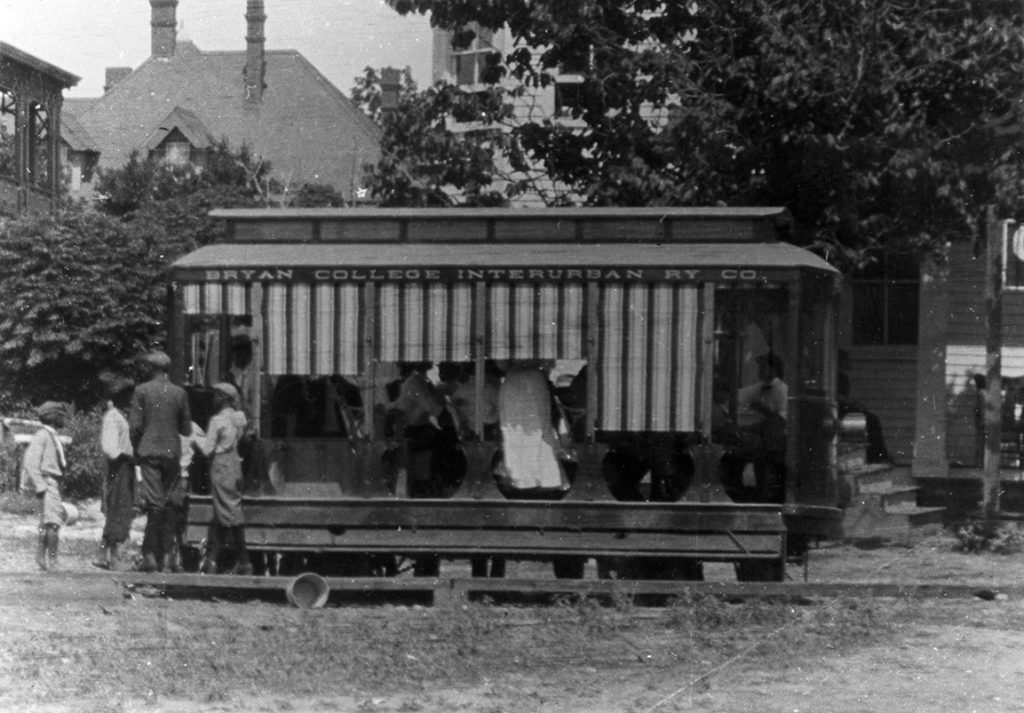
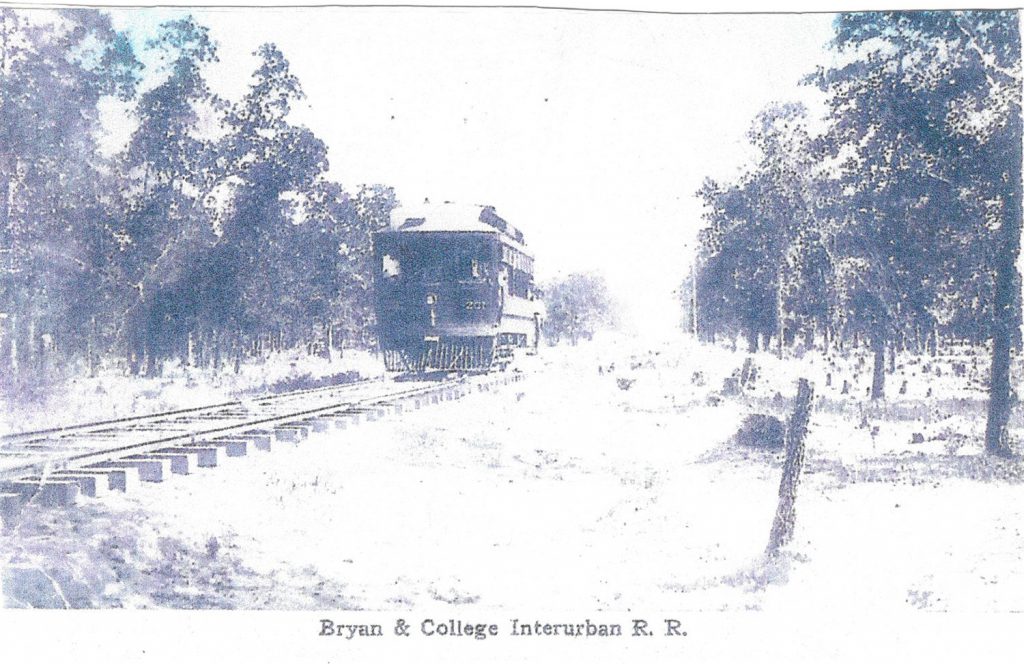
📷 Tickets please: View original tickets for the Bryan-College Interurban Railway trolley.
Progress, prosperity and lives in peril
You might say that the historic 1909 fires served as a kind of eulogy for the early days of Bryan, and they set the stage for what could be considered Bryan’s first renaissance: a rebirth into a rapidly modernizing world.
1910: Masonic temple next to today’s Palace Theater is constructed.
1910: Dellwood Park created thanks to the new trolley line. The creation of this amusement park, about halfway between Downtown Bryan and Texas A&M, was a way of socially connecting downtown with the college, as well as expanding Bryan’s footprint.
1910: Texas A&M cadets again celebrate in Bryan with a bonfire.
1910: Parker Lumber Building constructed.
Starting in 1910 and running for 13 years, the Bryan-College Interurban Railway was a trolley line that connected Bryan to Texas A&M, four miles to the southeast. The trip from Bryan took 30 minutes, and the cost to ride was 15 cents round-trip.
Its reliability was often called into question, particularly in its early years when it was propelled along its tracks by an underpowered gasoline engine. These early cars had to be pushed up the Hillcrest incline on Saturday afternoons when the trolley was crowded. Eventually, the trolley was converted to electric power in 1915.
When difficulties occurred (and they often did), the accepted cry was “Ladies, keep your seats; Profs, get out and walk; and Cadets, get out and push!”
By 1913, Bryan was really reaping the rewards of modernization, especially in terms of entertainment. According to local historian Henry Mayo, there were at least four movie theaters on the same block, and the names and owners of these theaters would often change.
Newspaper notices indicate that a “moving picture” theater was located on the bottom floor of the Exchange Hotel, beginning in early 1913. Appropriately, this predecessor to the modern-day Queen Theatre was named The Princess. The silent films shown at these theaters during this era were usually captioned, and background music was provided by an organ, or “fine Wurlitzer orchestra,” as The Princess had.
The name Princess seems to have lasted only a month or two before the theater was renamed The Palace – until Christmas Day in 1913. (This was not the location of The Palace of later years.) When a new theater manager, Eli Marks, came from Waco in early December 1913, he held a contest to rename the theater again. The winner of the $10 cash (gold) prize was Mrs. C. L. Eden, for her suggestion, The Crystal.
1911: City purchases its first electrical distribution system, and street lights on Main Street begin to be installed.
1912: Current Ice House building built at end of Main Street. (Note: There was an ice house there as far back as 1901, according to Sanborn fire insurance maps.)
1912: People’s Undertaking Company established to serve the African American community in Bryan and Brazos County.
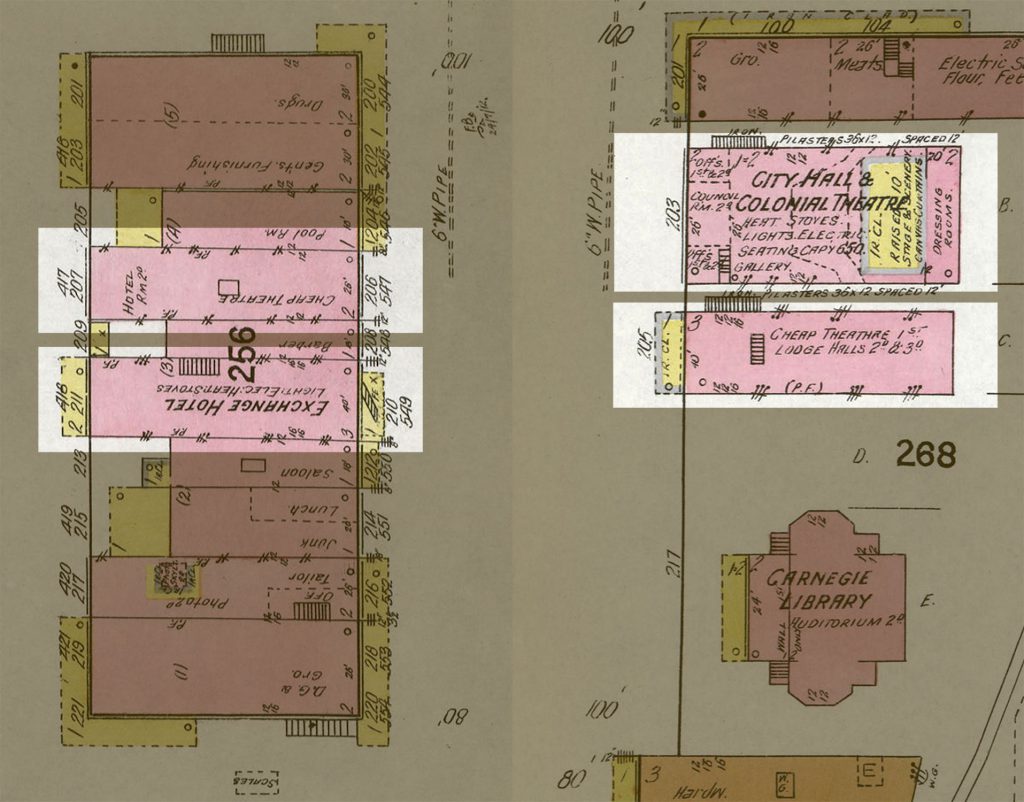
What’s in a name: There were no fewer than four movie theaters in Downtown Bryan by 1913, and these theaters changed names and owners often. This image from the 1912 Sanborn fire insurance map shows three of these theaters marked: The Colonial (today’s Palace), the cheap theater in the Masonic Lodge building and the cheap theater on the left, which was The Dixie. In 1913, the Exchange Hotel also started showing moving pictures on its first floor.
But the name-swapping continued just four months later in April 1914, when W.R. Fairman bought The Crystal and renamed it The Queen. Fairman also owned The Dixie, which was only two doors down from The Queen. Across Main Street was The Colonial, in the new City Hall building. The 1912 Sanborn fire insurance map also shows a “cheap” theater located on the first floor of the Masonic Lodge, next door to The Colonial. Dr. Oswell Person, in his book African American Bryan Texas: Celebrating the Past, describes yet another theater, the Starlight, that was in the north end of Bryan where the downtown African American businesses were concentrated. The Starlight had no racial restrictions on seating.
Everyone get all of that?
In less than 18 months the theater at the location of the present-day Queen had four different names and three different owners. Apparently, these ownership changes did not involve real estate and buildings, but only the theater businesses, equipment and fixtures. But these were big investments and required technical expertise to operate.
The 35mm nitrate film was highly combustible, as revealed by several newspaper articles about projector room fires, and advertisements for new movie theaters were often laden with references to the safety of the viewers and fire-proof projection rooms.
Less than two weeks after Fairman took over The Queen, “a very destructive film fire occurred…there being five films burned.” The theater then closed for some quick repairs. Less than two weeks later, the now-iconic Charlie Chaplin silent movie The Tramp played at The Queen.
1913: Bryan adds a number of city parks to its landscape, beginning with Oak Grove Park.
1914: St. Andrew’s Episcopal Church current building completed in Downtown Bryan.
1915: One of the four Texas A&M bonfires this year is in Bryan. The first bonfire that preceded a football game is held.
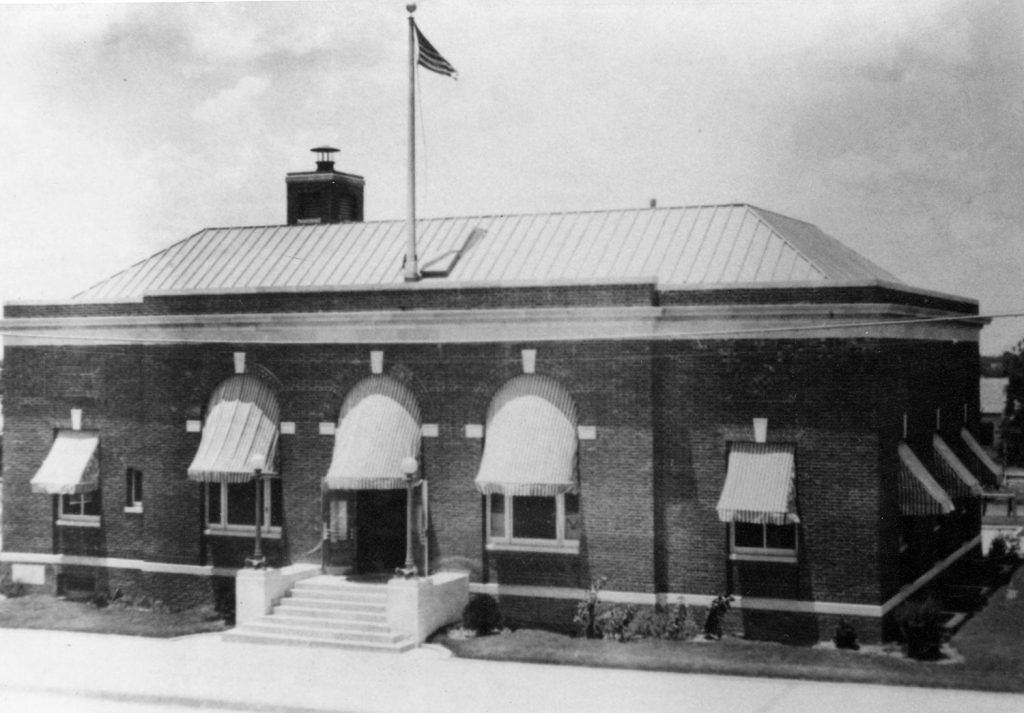
1915: The post office moves to the federal building, shown above, at the corner of Parker and 26th streets. With the move comes free city mail delivery. This is the first federal building in Bryan.
1915: First paved streets in Bryan are Main Street and Bryan Avenue. They are paved using mules, ploughs and a steamroller. New tall and slender streetlights are installed on corners, replacing shorter lights in the middle of Main Street.
1912-1913: Temple Freda synagogue building constructed
Saving history: In a beautiful story of community cooperation, the Temple Freda building was built with contributions from Jewish families as well as donations from their Christian neighbors. The building was dedicated in 1913 and has been undergoing a major renovation and restoration since 2017.
1916: The city park at 26th Street is the site of Bryan’s first public Christmas tree lighting.
1917: Military training is added to Allen Academy and continues as part of the curriculum until the 1980s.
1917: Astin Office Building, 106 W. 26th Street, is constructed. It housed the first Bryan telephone exchange and later was the home of City National Bank.
Another modern milestone occurred in 1913, when Dr. W.H. Oliver established Bryan’s first hospital on the west side of downtown. Located at the corner of Sims Avenue and W. 28th Street, the hospital was only a couple of blocks from Oliver’s own home on W. 26th Street.
Dr. Oliver graduated from Baylor University and the Tulane Medical College in New Orleans, and had gone abroad to further his studies. After stints in New York, Italy, France and Germany, he came home to the Brazos Valley and developed a reputation as one of the best doctors in Central Texas. It was not uncommon for people from across the state to seek his expertise.

First hospital: Dr. W.H. Oliver founded Bryan’s first hospital in 1913. He also made house calls. Perhaps that’s the reason he needed these bear-skin gloves.
🎧 Listen to Dr. Oliver’s grandchildren tell their stories of these gloves.
Dr. Oliver ran Bryan Hospital for 20 years and, according to the Bryan Daily Eagle from Feb. 7, 1933, he was working at the hospital on the day he died. But his legacy lives on. The hospital he founded would soon be renamed St. Joseph Hospital and would serve residents in this same location until the 1970s.
But 1913 wasn’t all progress and prosperity. No year truly is. This particular year saw one of the worst Brazos River floods in history. There had been a major flood on the river in 1899, and smaller floods were relatively common. But for four days in early December 1913, rainstorms created a new level of natural disaster for the Brazos Valley.
When flooding occurred along the river, Bryan residents were among those who came to the aid of stranded tenant farmers and their families, and this time was no exception. But this also wasn’t the typical flood.
News reports stated that for a stretch of 100 miles, the Brazos River was between five and 10 miles wide, and that further downstream toward Freeport, the Colorado and Brazos rivers had both overflowed their banks and had merged into one single river. Across Texas, 177 lives were lost.
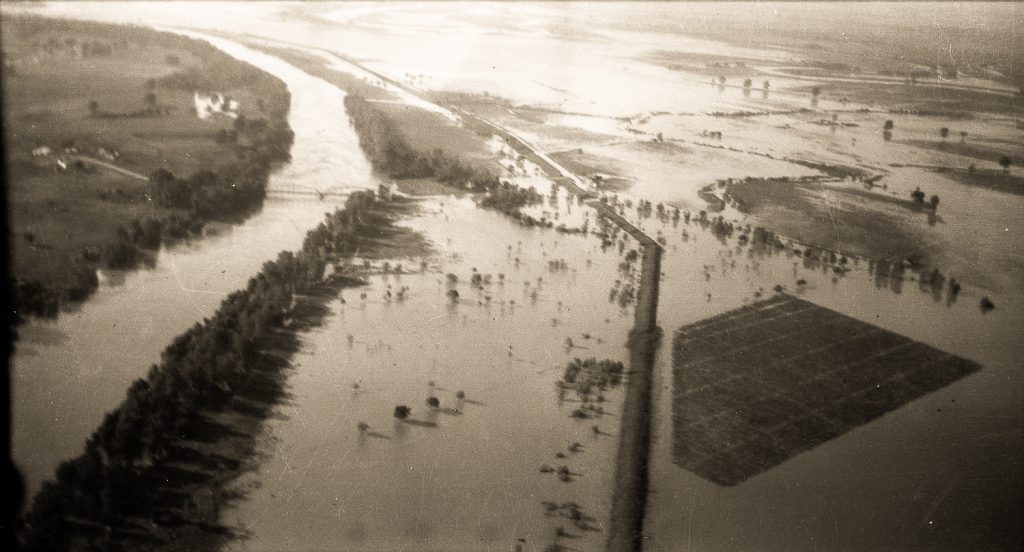
Brazos River flooding: The December 1913 flood was a disaster in every sense of the word. But it was not the first time the Brazos River had flooded, nor would it be the last. In 1921, another horrific flood would strike the Brazos Valley. The Office of the Texas State Climatologist described that 1921 flood as a result of “probably the greatest rainstorm in Texas history.”
It’s a little unclear how many Bryan residents died attempting to rescue those marooned by the flooding along the Brazos River. But we do know that at least three Bryan citizens drowned trying to save the lives of others. One of those was Howard Cavitt, owner of the Bryan Motor Car Company, who was deemed by the Bryan Daily Eagle in his obituary as “one of the most beloved young men of the town and county.”
Cavitt’s obituary in the Bryan Daily Eagle describes his untimely death in great detail:
With his characteristic bravery, and love for suffering humanity, Mr. Cavitt, with a party of four, went to the flood stricken district to aid and rescue those whose lives and property were being swept away by the mad waters of the raging river as it poured its terrorizing torrents over miles and miles of that thickly populated territory. …
After their boat was disabled and they were drenched and exhausted with the lashing waters, and the first two had been overcome by exhaustion, they tied the bodies of their dead companions to the tree to which they were clinging for safety, and Tom and “Cap,” as he was lovingly called by his many friends, climbed higher into the tree and took up their anxious gaze for help, together. Long they watched, amid the debris, carcasses, floating houses and dead bodies that hurried by them in the swift waters, trying to catch the glimpse of a rescue boat to take them to the shore. …
All night they called, and hoped, and prayed, but no help came, and just as the dawn of another awful day approached, death took the noble spirit of Howard Cavitt home to that Great Shore of eternal safety and rest.”
– The Bryan Daily Eagle, Dec. 8, 1913, Page 2.
If you were writing a tragic adventure novel, that’s how you would end it.
But time continues to move on in the real world, and this epic disaster would not be the last major flood of the Brazos River.
Just eight years later, another deadly and destructive flood would ravage the Brazos Valley, and the rest of South and Central Texas, in what has been described by the Office of the Texas State Climatologist as “probably the greatest rainstorm in Texas history.”
1910s: Progress, war and remembrance
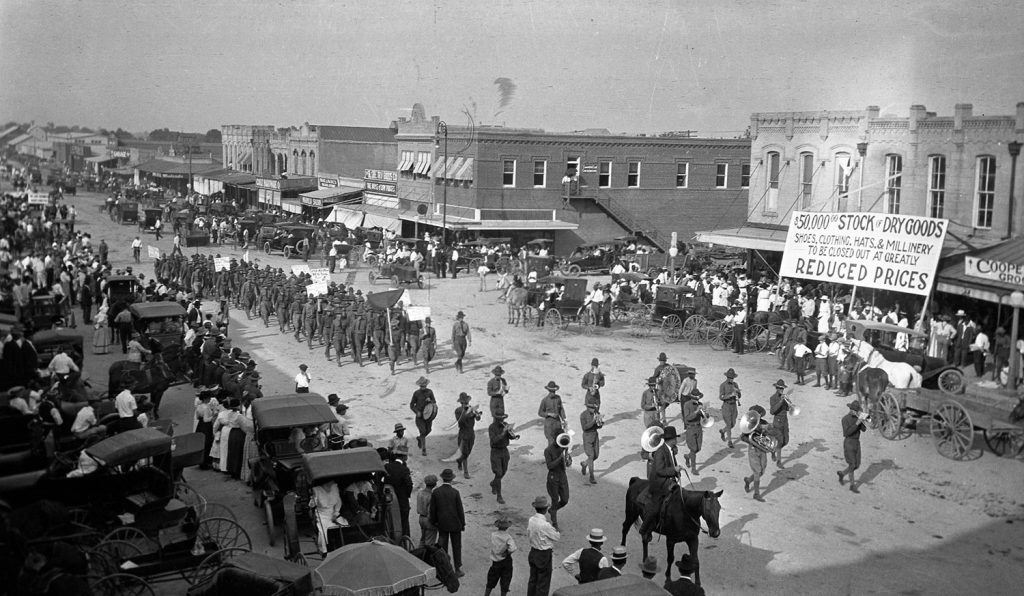
Downtown parade: This photo from the World War I era shows members of the Texas A&M Corps of Cadets marching down Main Street in Bryan.
The Great War and the toll that came with it
As the decade rolled along, Bryan’s downtown began to resemble the downtown that is familiar to us, with the construction of taller and taller buildings, paved streets and new modern streetlights. A new immigration boom began, this time from Mexico. Not even the trials and tragedies of war and pestilence in the late 1910s could stop Bryan from growing. In fact, Bryan and Texas A&M both played parts in these events of global significance.
It’s known as “The Great War” and “The War to End All Wars,” and it was the most horrific and destructive conflict in the history of the world up to that point in time. We’re not going to go into the long history of what caused World War I or the various actions taken on both sides. But we will just state one fact: From 1914 to 1918 more than 16 million people – soldiers and civilians alike – were killed.
And 42 of those who died were from Brazos County.
We’ve researched who from Brazos County actually died during the war, and we have a list of 42 people who were from here that went away and never came back. Even though many of these soldiers may have died because of the flu rather than in battle, that doesn’t matter. They were drafted, and then they had to leave home, and they never came back. In a town of 5,000, and you lose 42 people, that’s a huge tragedy.”
– Randy Haynes, City of Bryan historian
Early in the morning, at about 3:30 a.m. in Bryan, on Nov. 11, 1918, the news broke that an armistice had been signed and the war was over. The news came to the Bryan Daily Eagle office via the Associated Press, and a reporter for the newspaper contacted the telephone exchange and got the message to a man named John Daly.
Daly then began ringing the fire bell to alert the community that something big had happened. That same bell now sits outside Clara B. Mounce Public Library in Bryan as a monument to the end of “The Great War.” The Bryan Daily Eagle‘s article about the events of the day sheds light on exactly what happened and how this news affected our community.
The city was deep in slumber, but an accommodating young woman at the telephone exchange passed the word to John Daly, who set the fire bell going, others were aroused by phone and within thirty minutes the entire city was wide awake and celebration of the biggest event in history was soon in full swing. Every gun that could shoot, every bell that could be reached and every man that could shout, scream or whistle went into action. It was indeed a great occasion for rejoicing. People congregated down town long before daybreak to hear and talk of the great news by the light of huge bonfires. It was an exciting time, but everything passed off without incident.”
– The Bryan Daily Eagle, Nov. 12, 1918, Page 1.
The war was over, but the effects and a byproduct of this horrible conflict were taking their toll on the community.
It’s known today as the Spanish Flu, a new strain of influenza that ravaged the world and caused the deaths of more than 50 million people. But the Spanish Flu wasn’t originally from Spain, and the pandemic it caused was initially exacerbated by the transportation of troops across long distances and by wartime living conditions, both in the trenches in France and in the barracks at home.
From 1918 through 1920, the world suffered recurring outbreaks of this new and deadly virus, and Bryan and Brazos County were no exceptions.
During the war, A&M served as a U.S. Army training base. By September 1918, it had trained 4,000 soldiers in specialized skills such as auto mechanics, radio signaling, meteorology and many more. Cadets were getting their normal schooling at an accelerated rate, with direct ties to what was going on in the war. Simultaneously, thousands of regular Army soldiers were undergoing training on campus. This created a perfect environment for a flu outbreak.

Perfect storm: Texas A&M wasn’t only training cadets during World War I. The college was also training other soldiers. This helped create the perfect conditions for a flu outbreak in September and October 1918.
In September 1918 the second wave of the pandemic was in full swing in the United States, most heavily in the cities along the Atlantic Coast. By late September it was reported that the flu had hit Brazos County, and on Sept. 30 it was announced that A&M President William Bizzell had put the college in quarantine, preventing the students and soldiers stationed there from leaving campus.
The quarantine measures at the college were aimed at limiting exposure and preventing soldiers and students from using night trains, which might cause them to catch a cold that could develop into the flu, also called grippe. The flu rarely was the cause of death, but rather the development of pneumonia after the flu subsided.
The next day the first death on campus was reported as F.J. Butschek died of pneumonia contracted after a bout of the flu. Doctors in Bryan downplayed the seriousness in town, saying that the local epidemic was well in hand and that there were only two serious cases at the college.
August 1918: Ground is broken on a new high school in Bryan on Baker Street. The school had 40 classrooms and an auditorium that seated 1,000. It replaced the original Bryan Grade School that was built in 1880. Today it is the site of Fannin Elementary School.
In a letter dated Oct. 4, 1918, to Bryan resident E.H. Astin, President Bizzell stated that there were 1,000 cases of influenza on campus, and that the hospital was overtaxed and a barracks had to be converted into additional space. He also reported that more doctors and nurses were needed, something he had seen to by acquiring the services of doctors from Bryan and nurses from around the state.
As the epidemic continued to spread, activities around the county were affected. In an attempt to stem the transmission of the flu, schools, churches and businesses were all closed, and social events like dances and football games were canceled.
President Bizzell had also been working with the government to gain better care for the soldiers training on campus. Word was received on Oct. 10 that the federal government had authorized the construction of a hospital at the college for federal soldiers. The same day, a story ran on the front page of The Bryan Daily Eagle titled “Deplorable College Conditions Condemned by Defense Council,” claiming that the soldiers were receiving poor care and living in terrible conditions in Barracks Five. Bryan Mayor John M. Lawrence also sent a telegram to the commanding officer of Fort Sam Houston calling for an investigation.
On Oct. 14, The Bryan Daily Eagle printed Capt. John F. Gibson’s response to the claims of negligence and poor conditions in Barracks Five. Gibson was in charge of the soldiers’ care, and he rebutted all charges made in the newspaper and said the report was exaggerated and largely false. He further pointed out that only 13 soldiers had died so far from the outbreak, rather than the reported 20.
In a letter two days later to Astin, President Bizzell stated that conditions in Barracks Five had become deplorable and that he had been urged to go to Washington to see what could be done, at which point he obliged and had become ill himself on his trip to the nation’s capital. Bizzell also reported that the War Department had sent a medical inspector to the college to investigate the problem. Interestingly enough, President Bizzell went on to echo Capt. Gibson’s view of The Bryan Daily Eagle‘s coverage: that it was “very inaccurate but did not overstate the general conditions.”
Conditions eventually improved on campus and in Bryan, and by the end of October the epidemic had largely passed at the college and around Brazos County. But it had taken its toll.
The local Spanish Flu epidemic had claimed 25 lives at the college, while 51 had been identified as dying around the rest of the county – a significant number in a community this size. There may have been another 10-20 deaths that resulted from the flu in October 1918, but these can’t be confirmed, as the death certificates simply stated “No Dr” as the cause of death.
1918-1920: Social issues take the stage
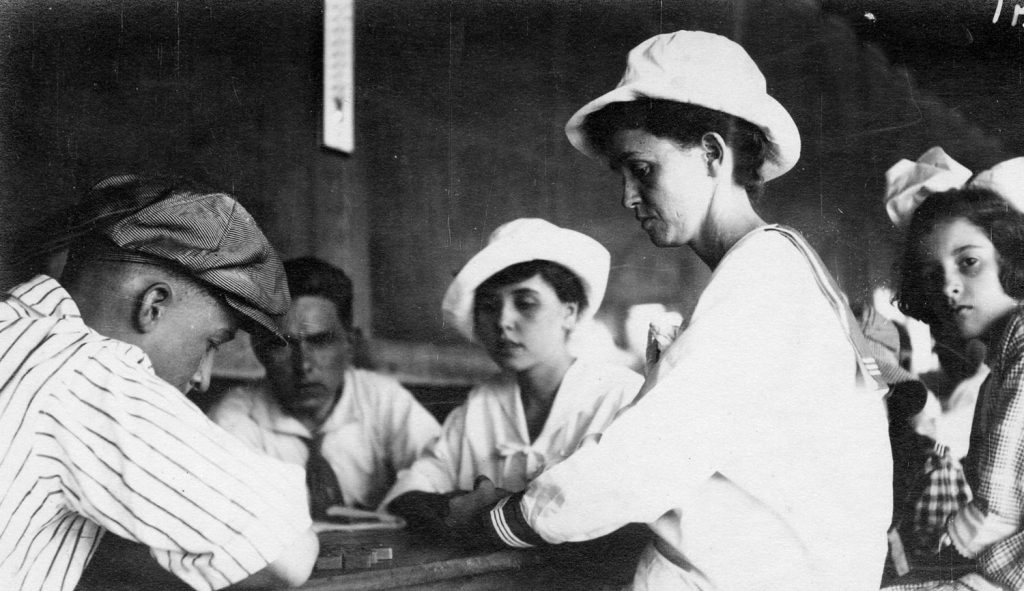
A larger role for women in society: Labor shortages during the war opened new opportunities for women in fields that had long been off limits, including manufacturing and the textiles industry. This helped spur the 19th Amendment to the U.S. Constitution, giving women the right to vote in 1920.
Social changes in
the postwar world
Though the tragedies of war and pestilence took a toll on this community, and the United States in general, there were positives that emerged from these trying years.
1919: Brazos County chapter of NAACP is formed.
1919: The citizens of Bryan officially own what was then called the Bryan Power Company. At this time there were about 768 customers being served by the company, primarily for lighting. This organization would later become Bryan Texas Utilities (BTU).
Perhaps the most important of these silver linings was the inclusion of more women in the workforce during the war and flu pandemic. Labor shortages during the war opened new opportunities for women in fields that had long been off limits, including manufacturing jobs and positions in the textiles industry.
In a 2018 article written by Christine Crudo Blackburn, Gerald W. Parker and Morten Wendelbo for the scholarly website The Conversation, the authors describe the effect that more women joining the workforce had on the nation during this period:
Increased participation in the workforce allowed many women to obtain social and financial independence. Leadership positions within the workforce could now be occupied by women, especially in the garment industry, but also in the military and police forces. … An increased ability to make decisions in their personal and professional lives empowered many women and started to elevate their standing.
With the war over and increased female participation in the labor force, politicians could not ignore the critical role that women played in American society. Even President Woodrow Wilson began to argue in 1918 that women were part of the American war effort and economy more broadly, and as such, should be afforded the right to vote.”
– Texas A&M Today, March 1, 2018. Originally published in The Conversation. Christine Crudo Blackburn, Gerald W. Parker of Texas A&M Bush School of Government and Public Service; Morten Wendelbo of American University in Washington, D.C.
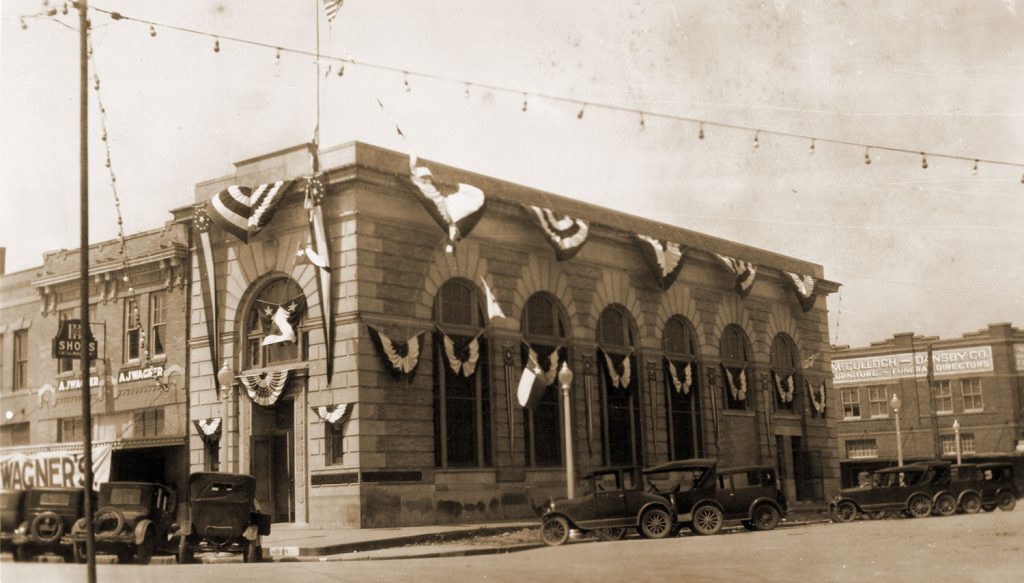
1919: First National Bank erects its new building, which contains the first night depository in the nation. The bank traces its roots to 1862, when a money-lending business opened in Millican. It was later purchased by Guy M. Bryan, son of William Joel Bryan, and the Bryan family had a leading role in the bank for many years.
The suffrage movement in America had finally turned the tide, and the 19th Amendment to the U.S. Constitution, granting women the right to vote, was certified on Aug. 26, 1920. Sadly, the 19th Amendment did not actually grant all women the right to vote. While it gave most white women this right, many women were still denied the power to vote based on their race.
Jim Crow-era laws and intimidation tactics from organizations like the Ku Klux Klan, which saw a resurgence in the 1920s, continued to create barriers for people of color to vote. For African Americans, Native Americans and other Americans of color, the struggle for voting rights, for both men and women, would continue for years and decades to come.
Another social issue that had been debated for decades would also finally gain the majority in public opinion in the years after the war. Prohibition, the 18th Amendment to the Constitution, which banned the manufacture, transportation and sale of intoxicating liquors, was ratified by the states on Jan. 16, 1919, and officially went into effect on Jan. 17, 1920, with the passage of the Volstead Act.
But the seeds of the Prohibition movement locally stretched back decades into the 1890s and the Women’s Christian Temperance Movement. This movement, paired with the ability of Texas counties to decide rules about liquor at a local level, resulted in multiple votes, parades, rallies and other demonstrations in Bryan in the early 20th century in an effort to ban liquor and associated saloons from the community.
Interestingly enough, it doesn’t appear that these local attempts to ban liquor at the county level ever got enough votes until the state and national breakthrough in 1919.
So how did Prohibition affect Bryan’s businesses and the community in general? Well, it doesn’t seem that it really had much of an impact.
Merchants who specialized in liquor sales moved into other areas of commerce. Some just expanded into full grocery or dry goods stores. Sure, saloons may have closed, but we all know that closing a saloon didn’t stop people from drinking. Prohibition was notoriously difficult to enforce. This was the era of the speakeasy and the bootlegger. The 1920s were called “The Roaring 20s” for a reason.
1920s: Prosperity and poverty rolled into one
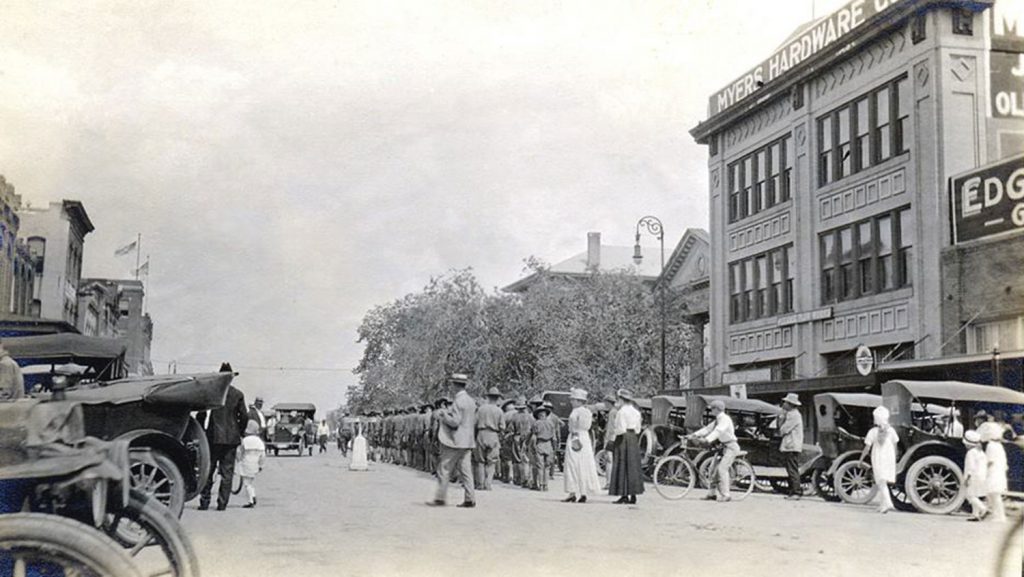
Dawn of the 20s: Downtown Bryan was taking on a shape that is very familiar to us today, and it would continue to do so over the next decade.
“The Promised Land” for some, but not all
The 1920s saw the creation of many of the most recognizable locations in modern-day Bryan. The iconic Sue Haswell Memorial Park took shape, the LaSalle Hotel was constructed on Main Street, and ground was broken on a new City Hall on E. 27th Street.
1919-1925: Streetlights begin to be installed in residential areas.
1922: Bowie School is built adjacent to the West Side School. The West Side School is razed for the construction of a gymnasium for Bowie.
1922: C.B. Hudson coaches the Bryan High School football team to victory in the first-ever University Interscholastic League (UIL) state football championship.
Newer and newer technologies continued to roll out seemingly every day. More and more areas of Bryan were becoming electrified, and street lights began going up in residential areas. Bryan was described in newspaper advertisements back East as “The Promised Land.”
One man from Brooklyn saw one of these advertisements in a newspaper in New York and decided to come see for himself. August B. Andersson was born in Sweden and immigrated to New York in April 1899. He had grown up on a farm in Sweden, but over the next 25 years, he started a family and worked and lived in New York.
In 1927, after seeing the newspaper ad – “Come to the Promised Land: Bryan, Texas” – Andersson decided it was time for a change. In April 1927, he traveled to Bryan, where he purchased a farm, and then returned to New York to collect his family and move them all to “The Promised Land.”
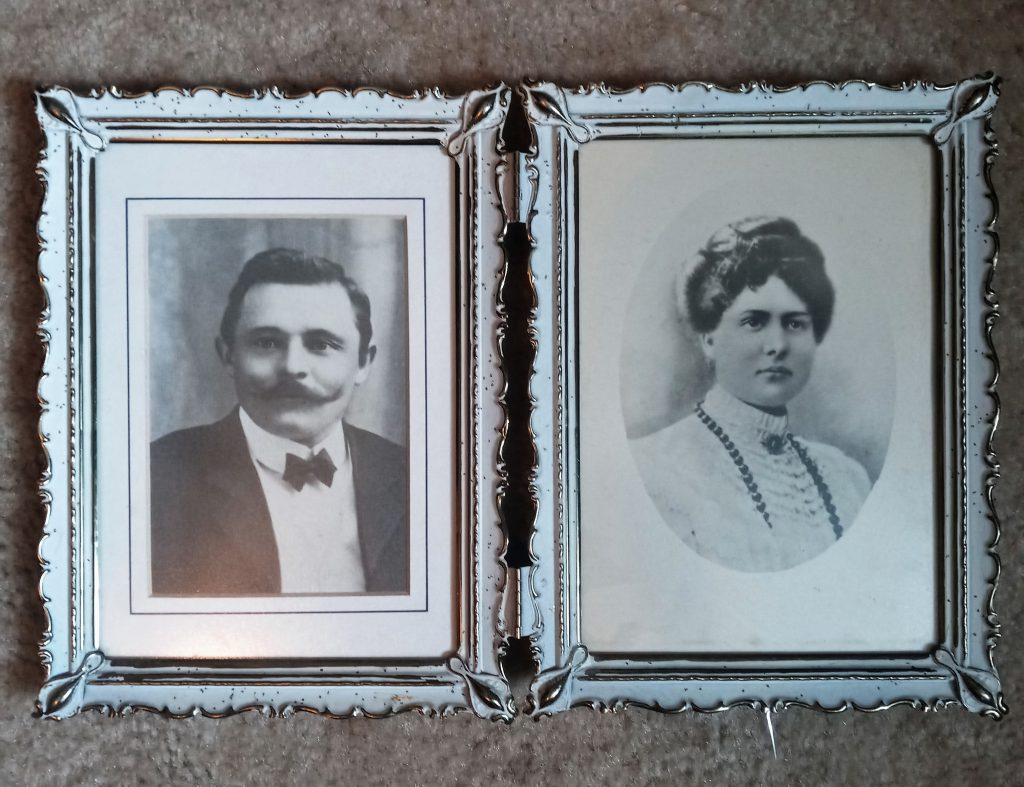
🎧 From Brooklyn to Bryan: Listen to the story of how August B. Andersson and wife Frieda Walter Andersson moved with their family to Bryan in 1927.
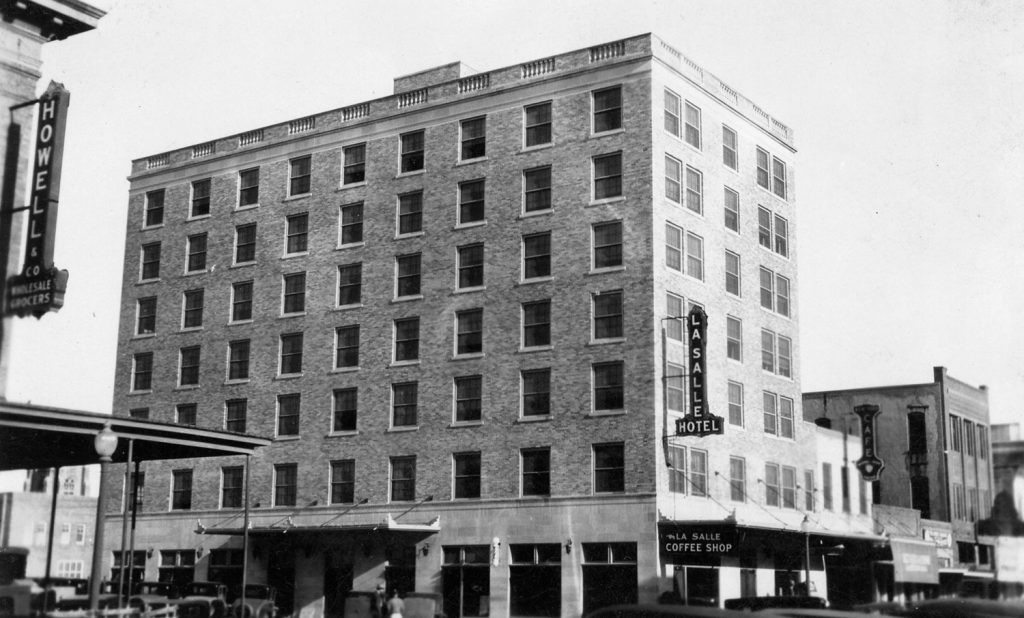
1928: The seven-story LaSalle hotel is completed in 1928 for leading businessman Robert Wistar Howell. The LaSalle is the tallest building in Downtown Bryan at the time of its construction.
For many, Bryan was a land of opportunity, and father and son partners Abraham and Morris Schulman planned to make a splash in downtown. Arriving in Bryan from Houston in 1926, the Schulmans purchased The Dixie, The Queen and The Colonial / Palace theaters from W.R. Fairman, contracting to pay a total of $25,000 for all of the equipment and fixtures of those three theaters.
Abraham Schulman had worked in movie theaters for almost 20 years, going back to his days on Canal Street in New Orleans. Morris had grown up in the business and had managed several theaters in Houston. The Schulmans’ new ownership as the Bryan Amusement Company finally brought stability to these entertainment venues on Main Street and actually paved the way for a new City Hall to be built just a few years later.
1929: A football field is built for Bryan High School.
1930: The area just north of Texas A&M is incorporated as part of Bryan.
1930: First State Bank & Trust Co. Building is built at 200 N. Main St.
1929 – New City Hall groundbreaking: Listen to City of Bryan historian Randy Haynes tell about the groundbreaking for the new Bryan Municipal Building in 1929, and why one photo is so important.
While it may have been “The Promised Land” for some, for roughly half the population of Brazos County, life was hard.
1930: The name of Bryan School for Colored is changed to Washington Elementary School.
1930: E.A. Kemp Junior-Senior High School is constructed on W. 19th Street to serve African American students.
The Mexican immigration boom that began in the 1910s saw many middle-class Mexicans arriving in Texas and the Brazos Valley, probably encouraged to leave their homes because of the Mexican revolution. This wave of immigration would continue throughout the 1920s, bringing a large group of unskilled laborers into an employment landscape where they often had few options other than manual labor.
Similarly, life continued to be difficult for African Americans. Segregation and the policies of the Jim Crow era, as well as the resurgence of organizations like the Ku Klux Klan, limited the overall upward mobility of the African American community in Bryan. Dr. Oswell Person describes the job outlook for most African Americans in this era in his book African American Bryan Texas: Celebrating the Past.
Employment opportunities were limited to only a few job fields, and most of these were at the bottom of the job well. They worked the dead-end, custodial, menial and pitifully low-paying jobs. Those who were employed as drivers for private van companies, telephone operators, chefs and head cooks and Lilly Ice Cream workers may have had better experiences, but these exceptions only made up a small percentage of the African American working class. …
Private businesses and city employment were not sufficient to sustain both the white and African American workforce, and many African Americans found themselves chopping and picking cotton in the Brazos River Bottom.”
– African American Bryan Texas: Celebrating the Past, Pages 67, 73.
Yet, despite these hardships and struggles, some members of the African American community were able to achieve great things. Dr. William A. Hammond Sr. was one of these leaders.
Dr. Hammond was one of the earliest African American surgeons in Bryan. After graduating from Prairie View A&M, he earned his medical degree from Meharry Medical College in Nashville, Tenn., in 1916. Moving to Bryan from his hometown of Hammond, Texas, Dr. Hammond started a clinic-office where African Americans could receive professional consultation and medical care. Prior to this, African Americans in Bryan and Brazos County had no real option to get professional and medical services.
In 1929, Dr. Hammond went one step further, opening the Hammond Memorial Hospital at the corner of W. 17th Street and Randolph Avenue. This 16-bed facility would serve the African American community in Brazos County for more than two decades until operations ceased in the 1950s.
Triumphs despite segregation: In spite of the challenges for African Americans in getting an education in the early 20th century, Dr. William A. Hammond Sr., seen here in his office and with four nurses, was a successful doctor in Bryan. Wayne Sadberry, curator of the Brazos Valley African American Museum, discusses Dr. Hammond, those educational challenges and what can be learned from this time period.
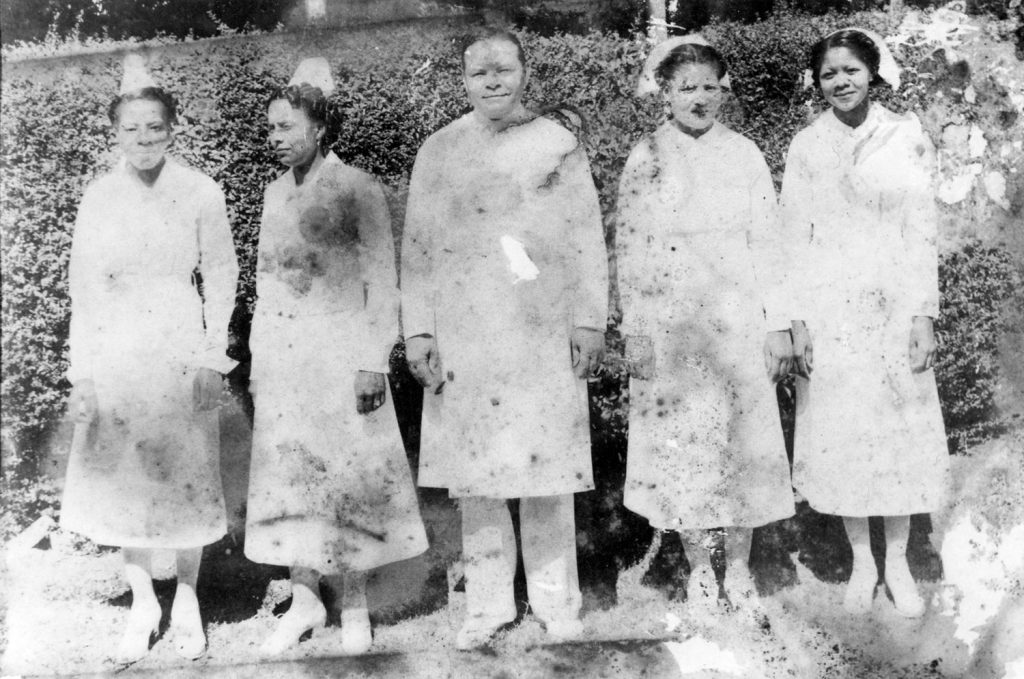
In addition to his medical achievements, Dr. Hammond was an entrepreneur and humanitarian in the African American community. He purchased land for the Grandview Cemetery for African Americans and was involved in other civic organizations, such as the NAACP, the Negro Chamber of Commerce and the PTA. He owned rental houses that provided homes for low-income families. He owned a lumberyard and founded a kindergarten. He also owned a laundry and dry-cleaning operation with pick-up or delivery service. And throughout all of these ventures, he provided employment to a number of African American families.
The 1920s roared all right, in good ways and bad. But the October 1929 stock market crash – considered the worst single economic event in world history – let the nation know that the party was over. What would come to be known as the Great Depression had begun.

